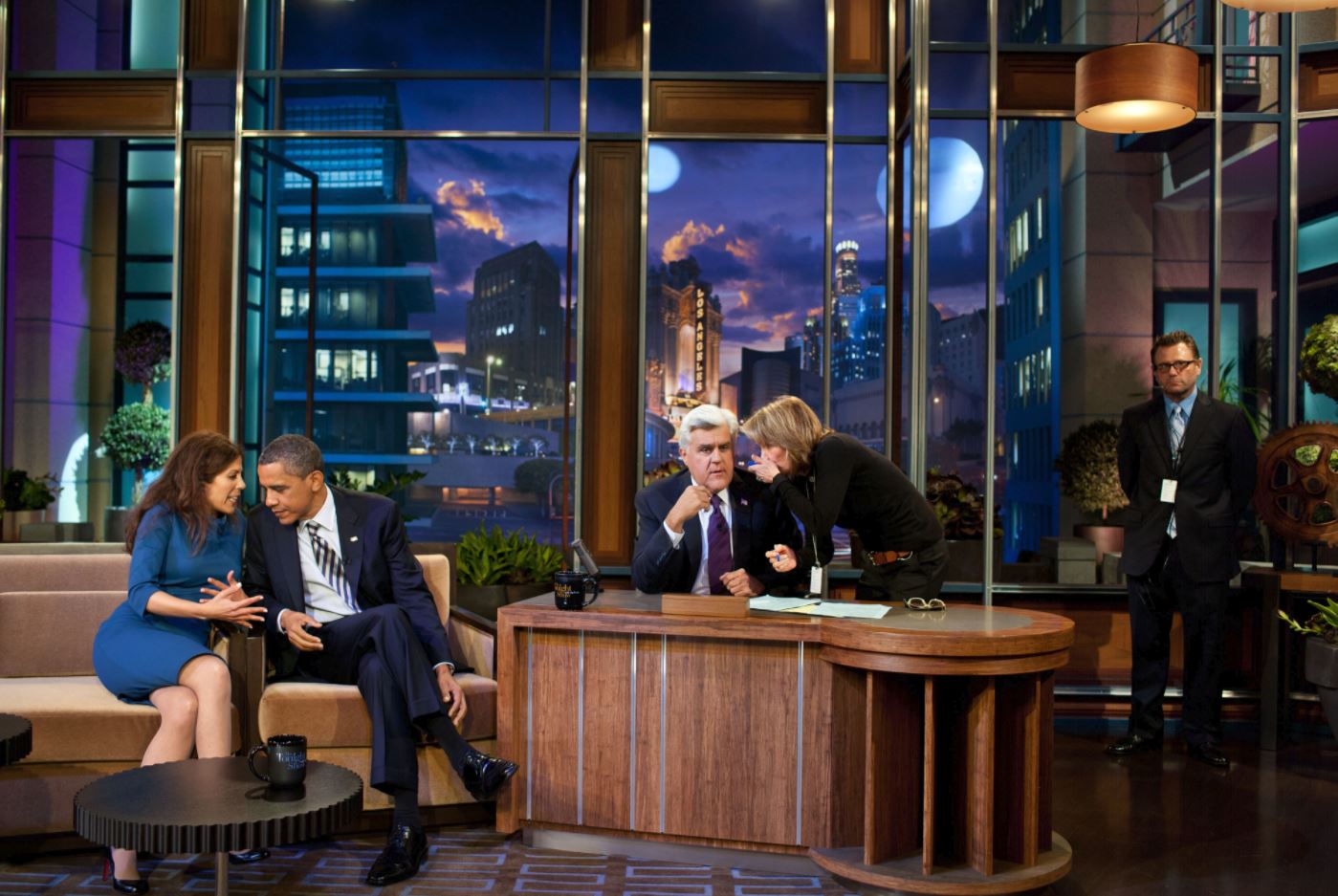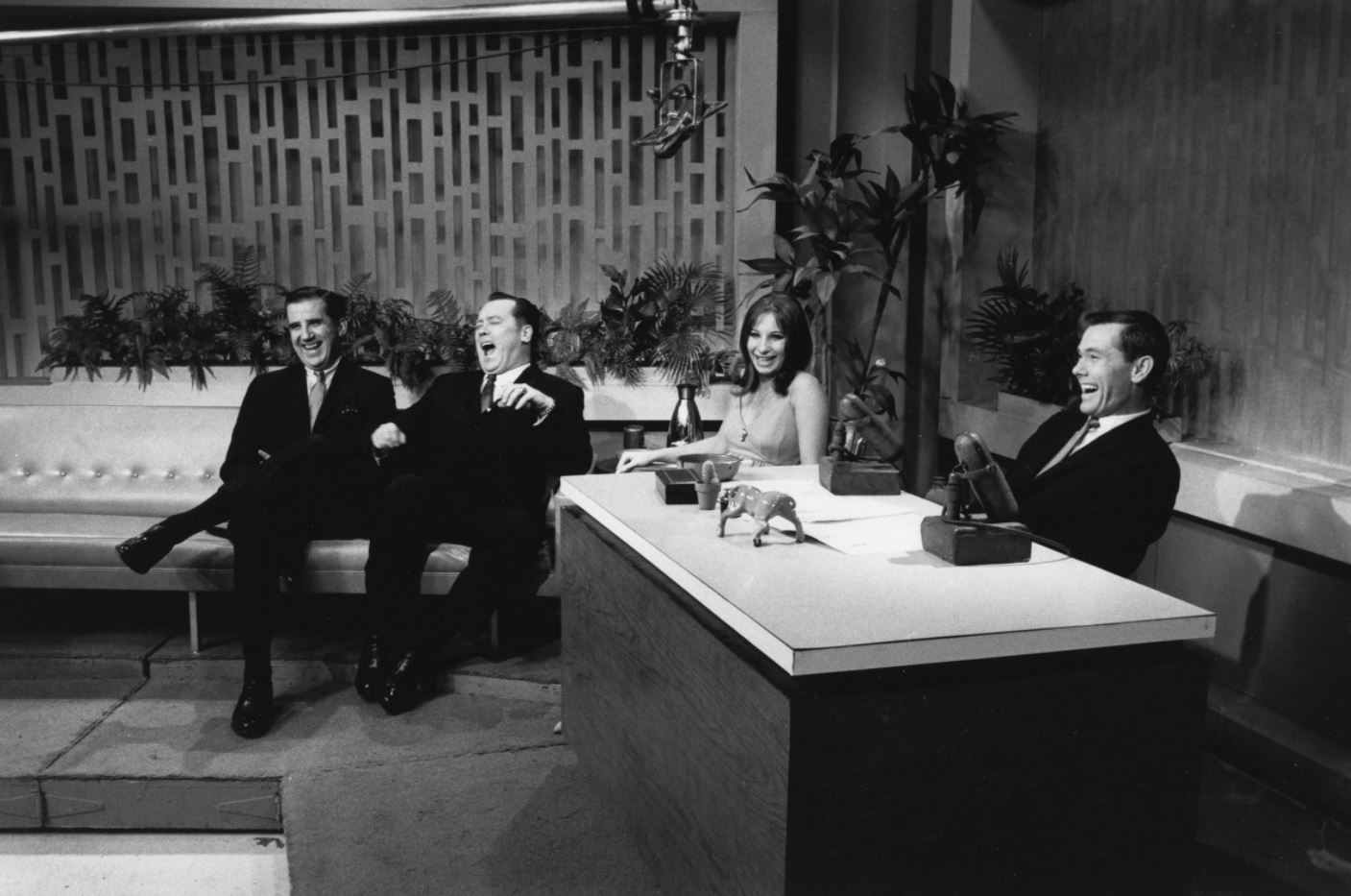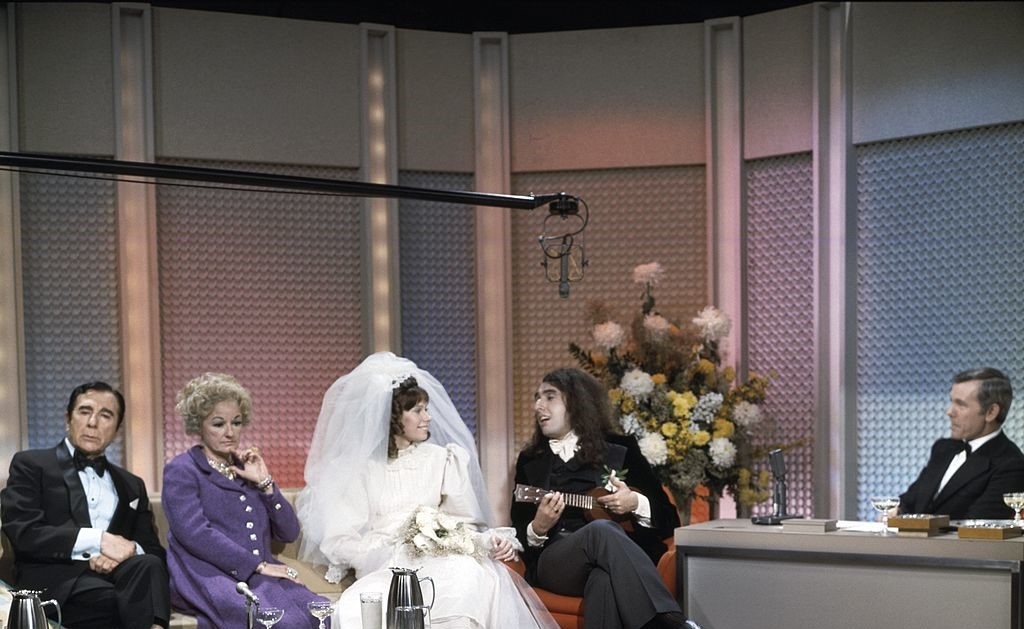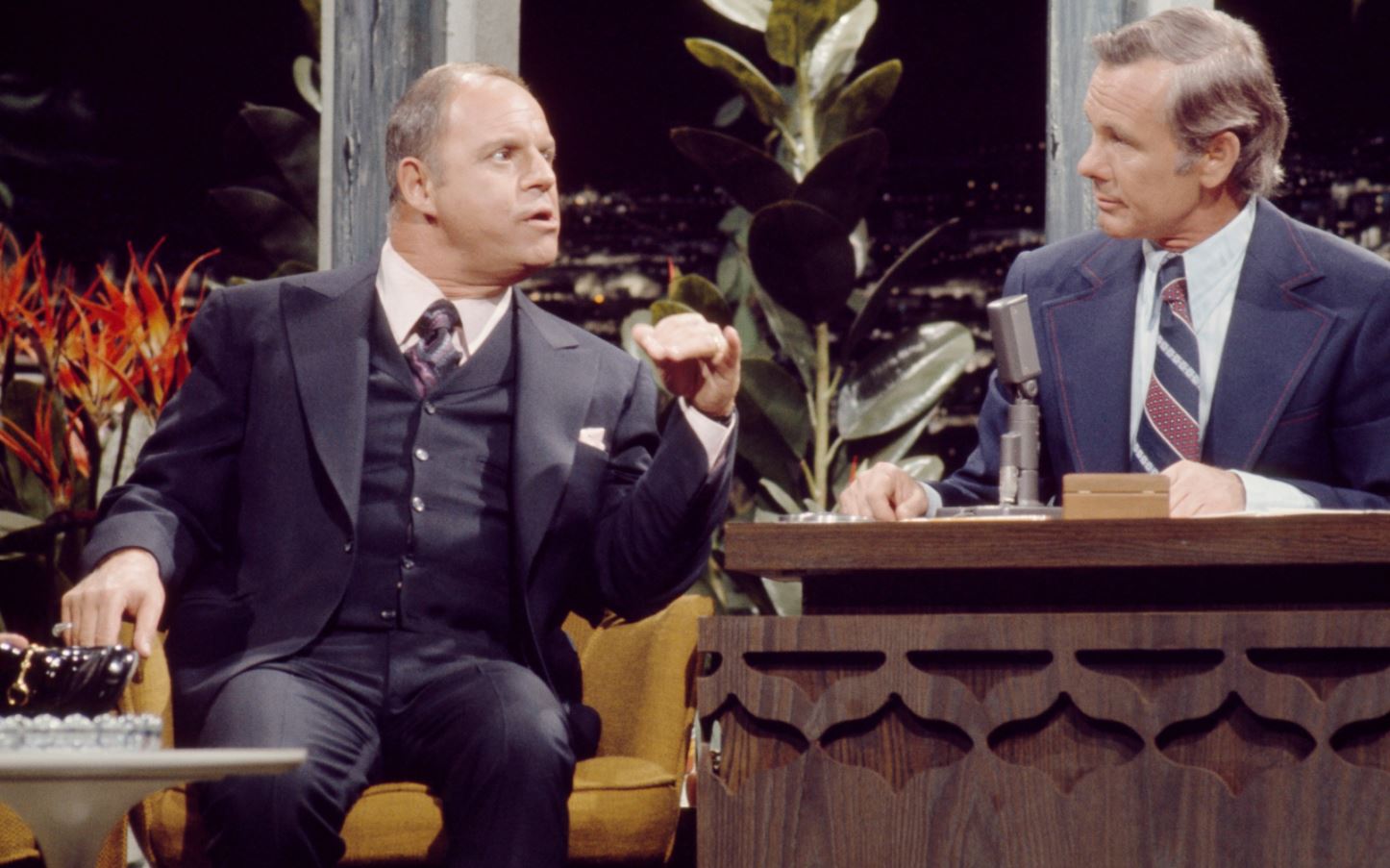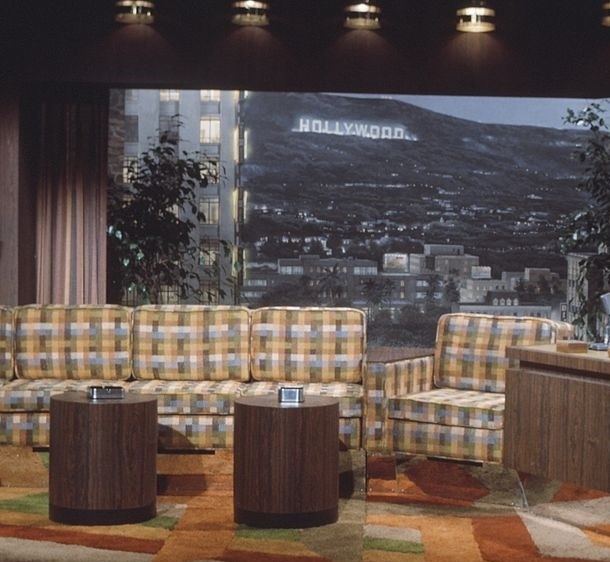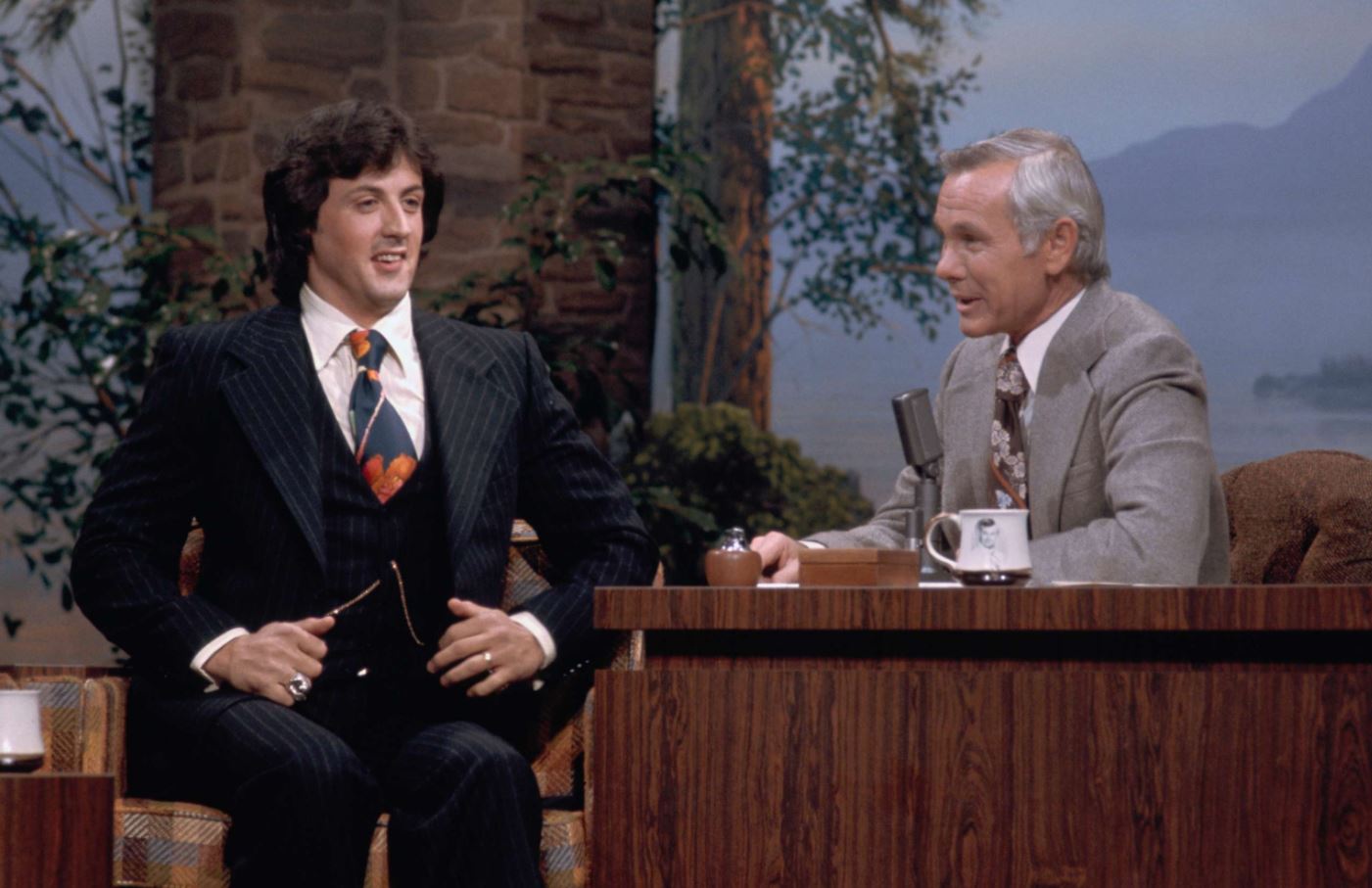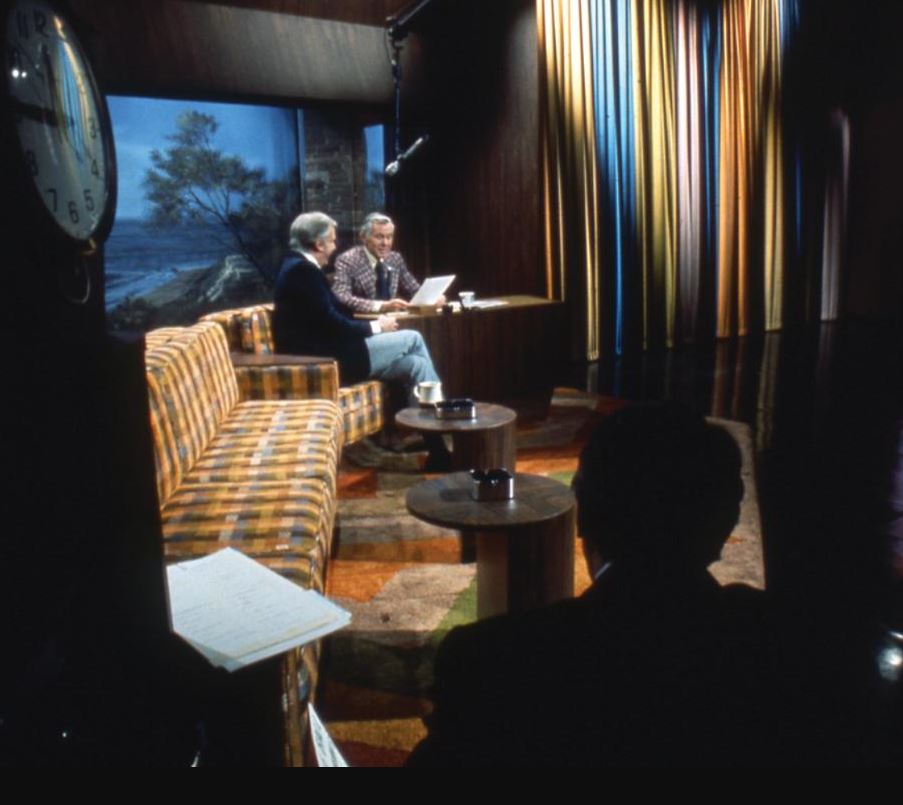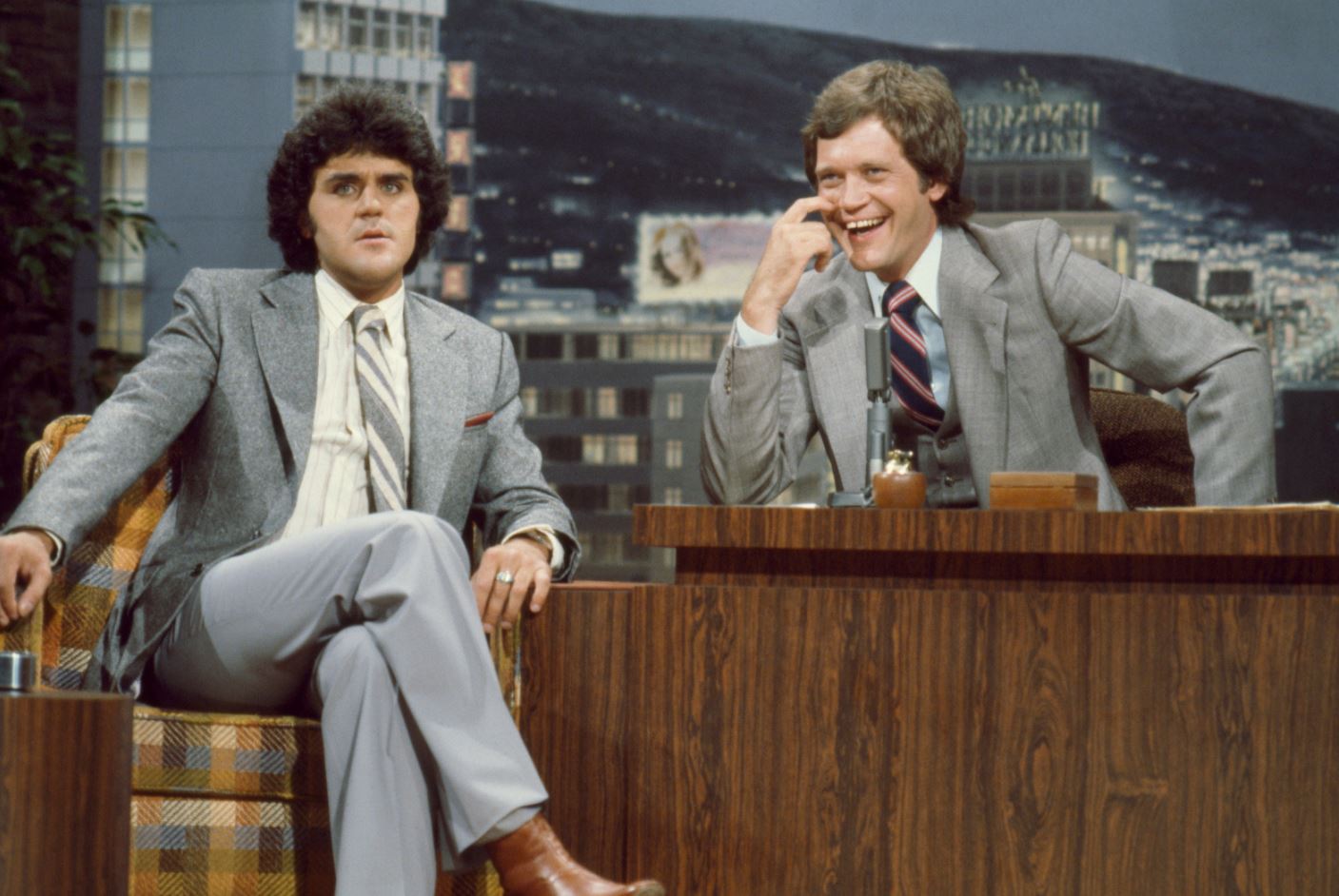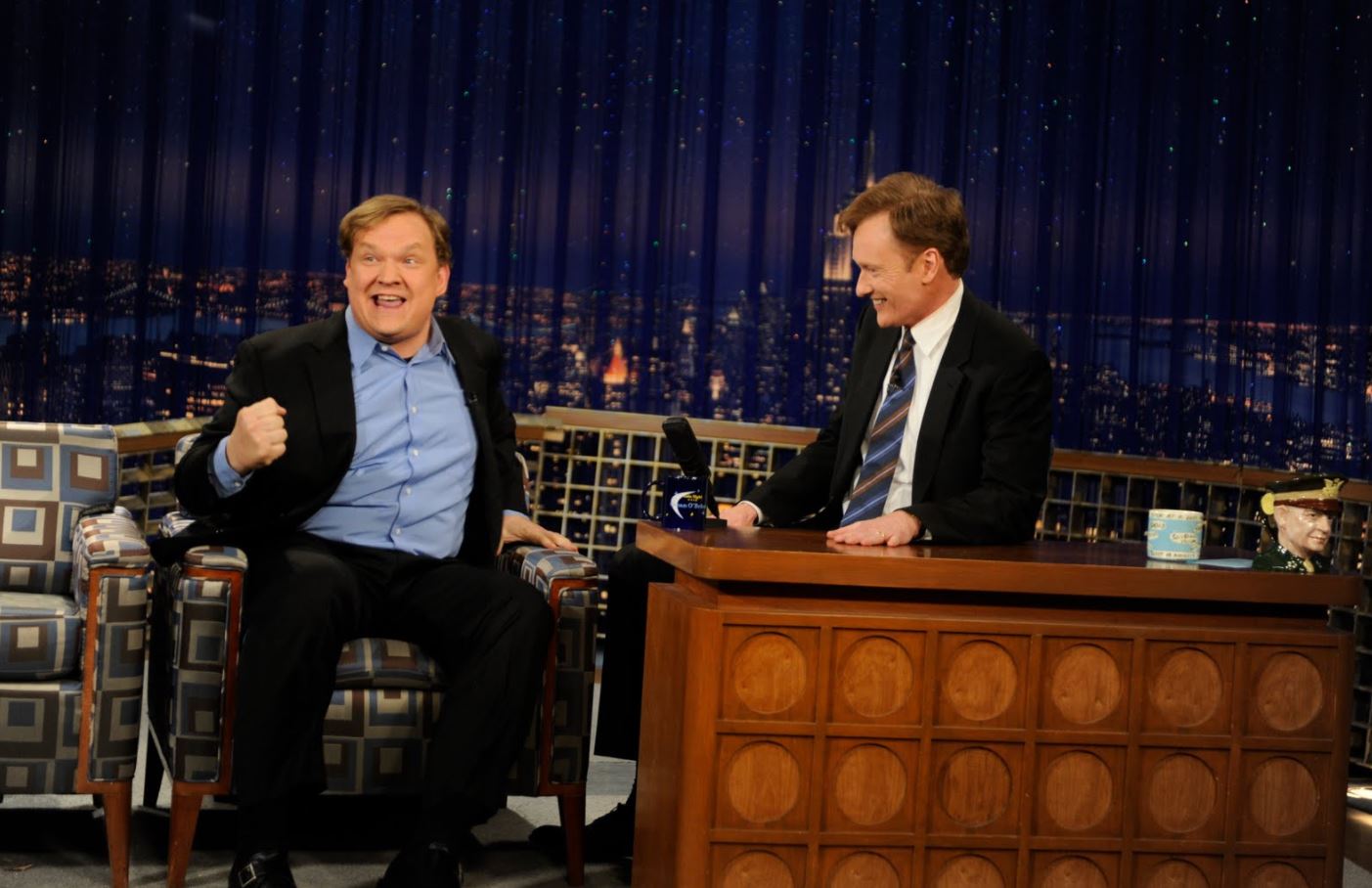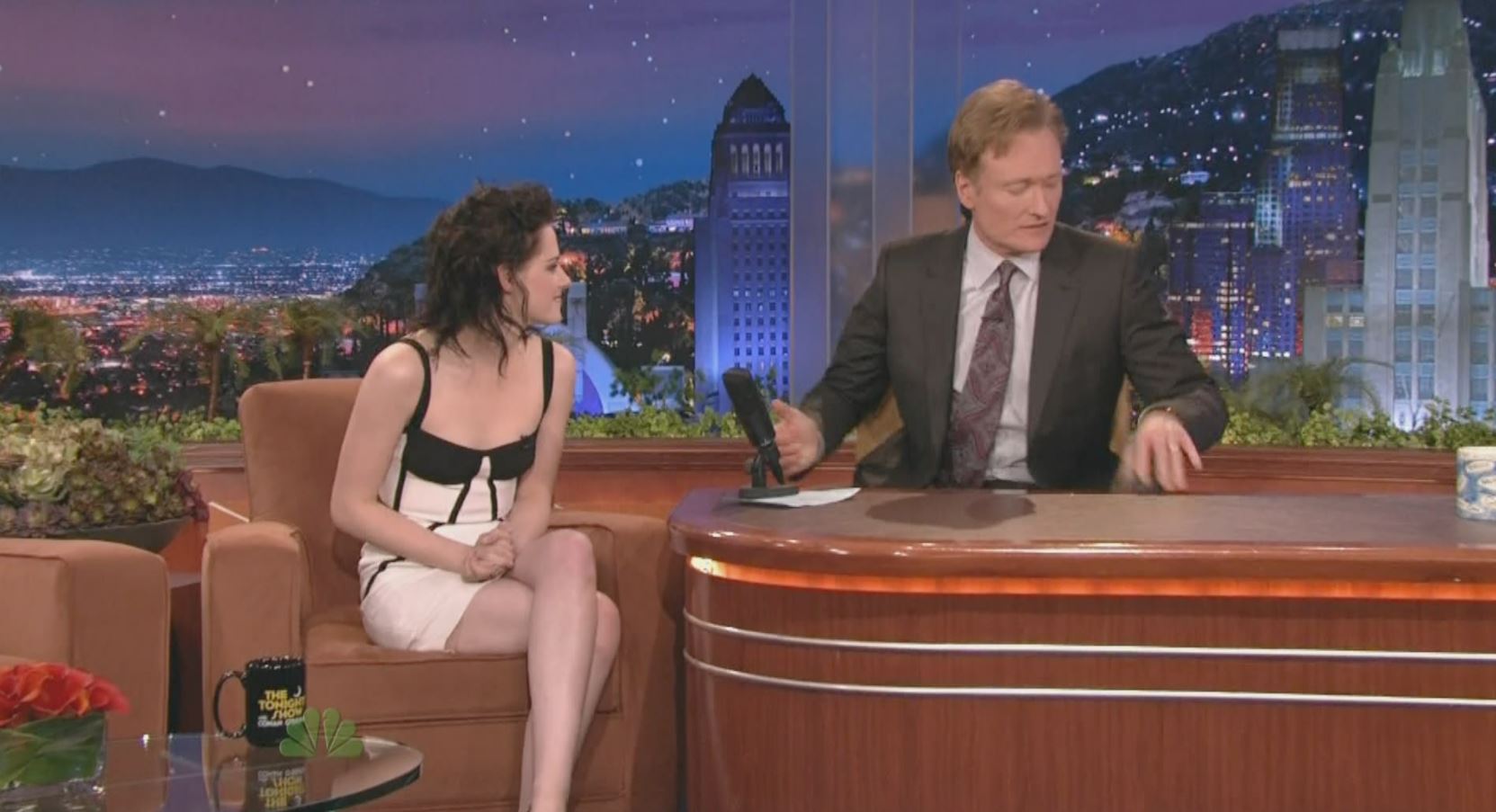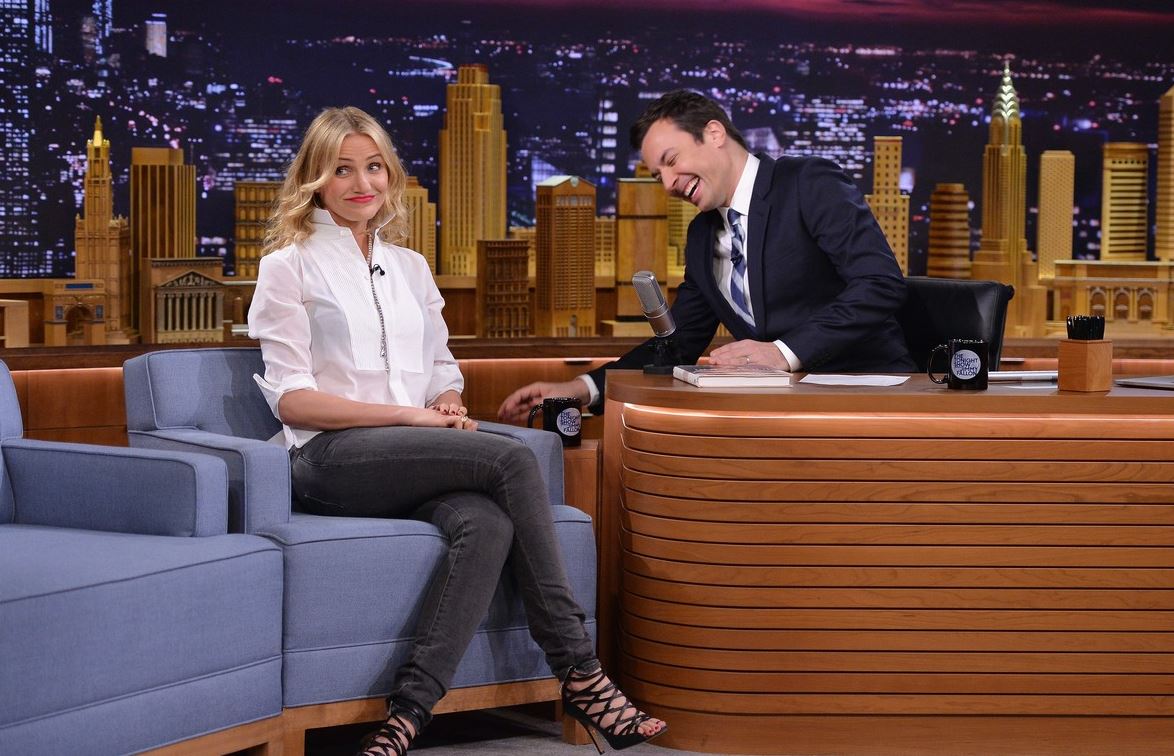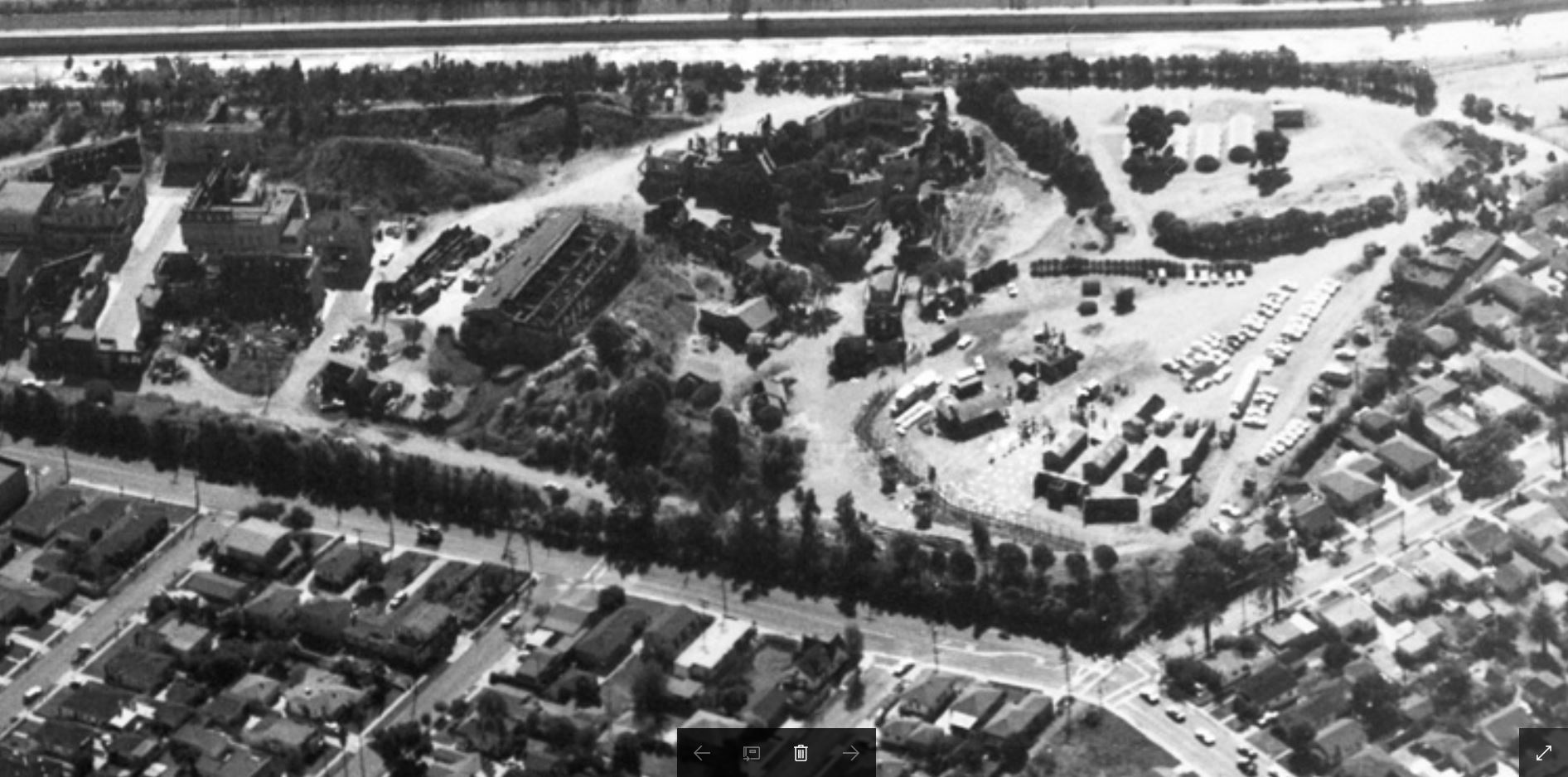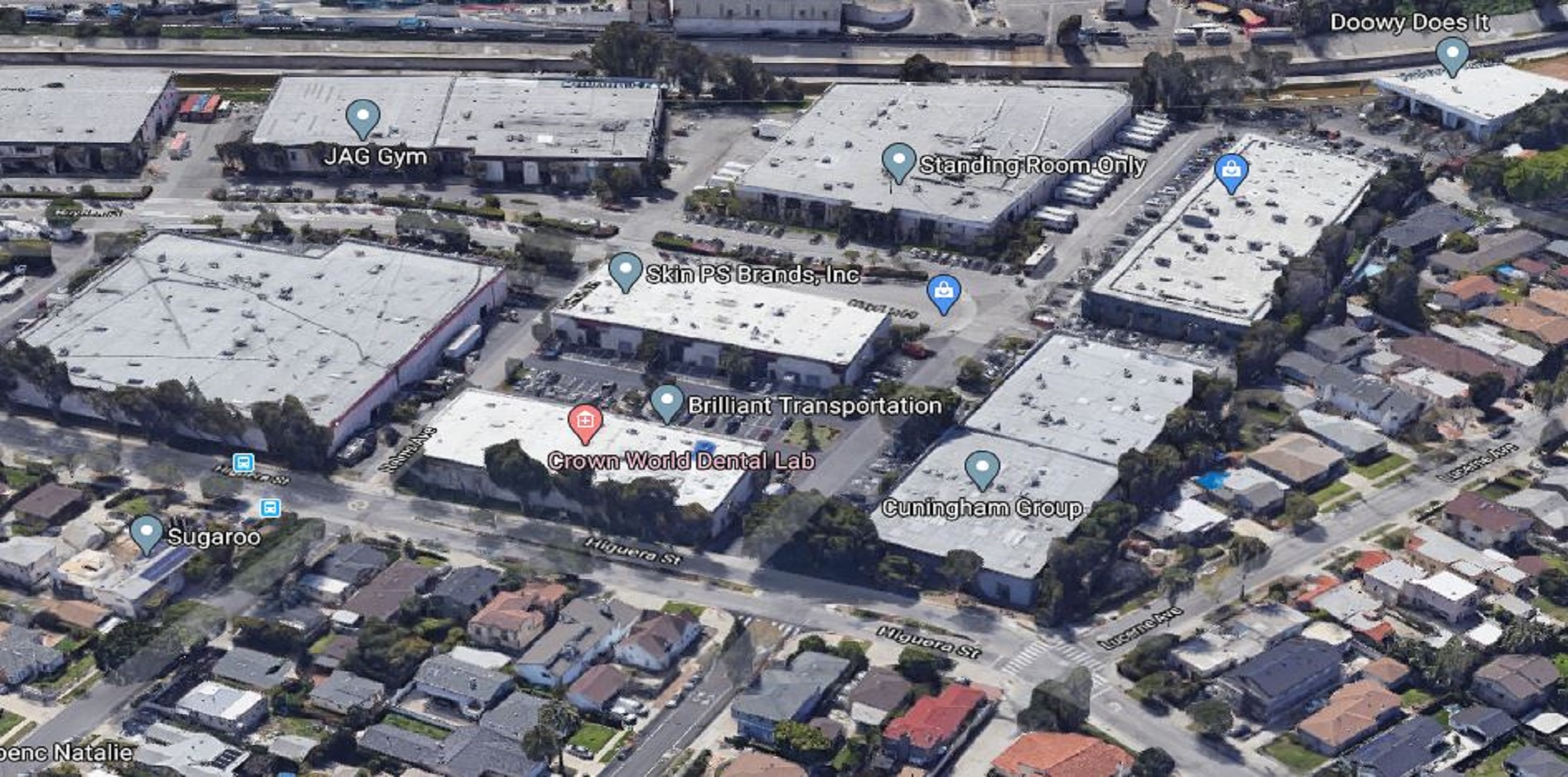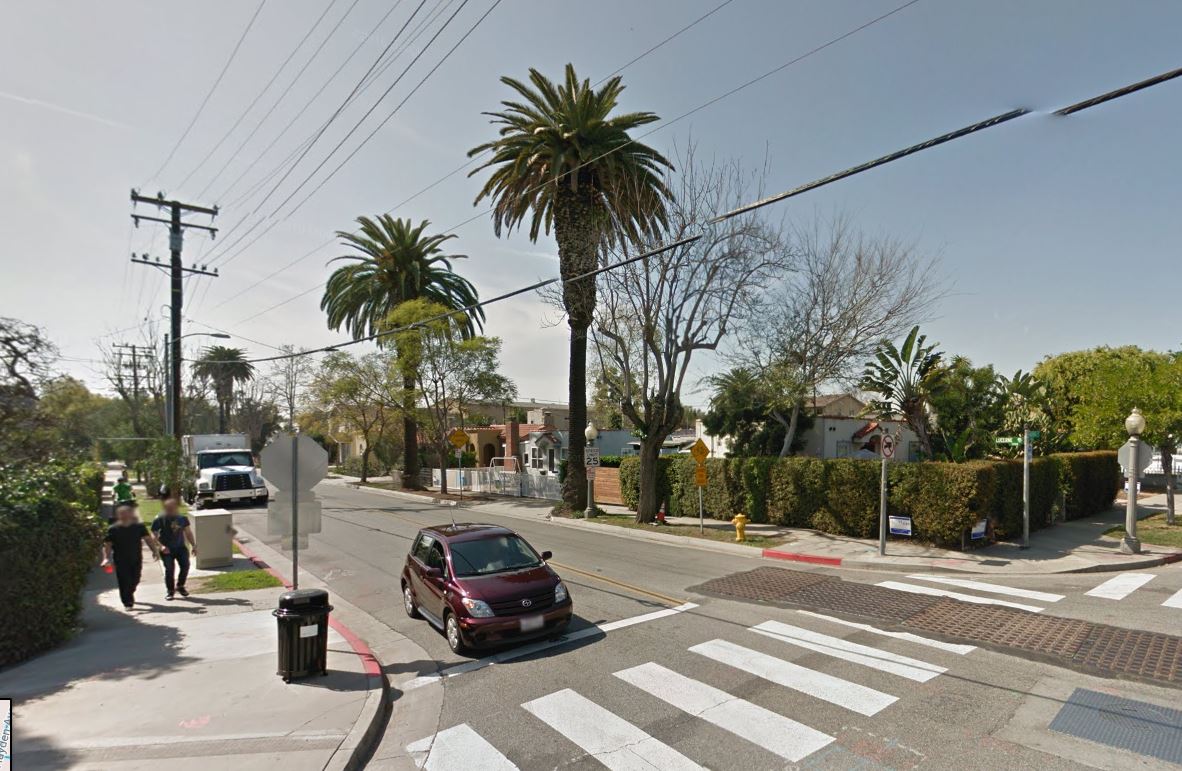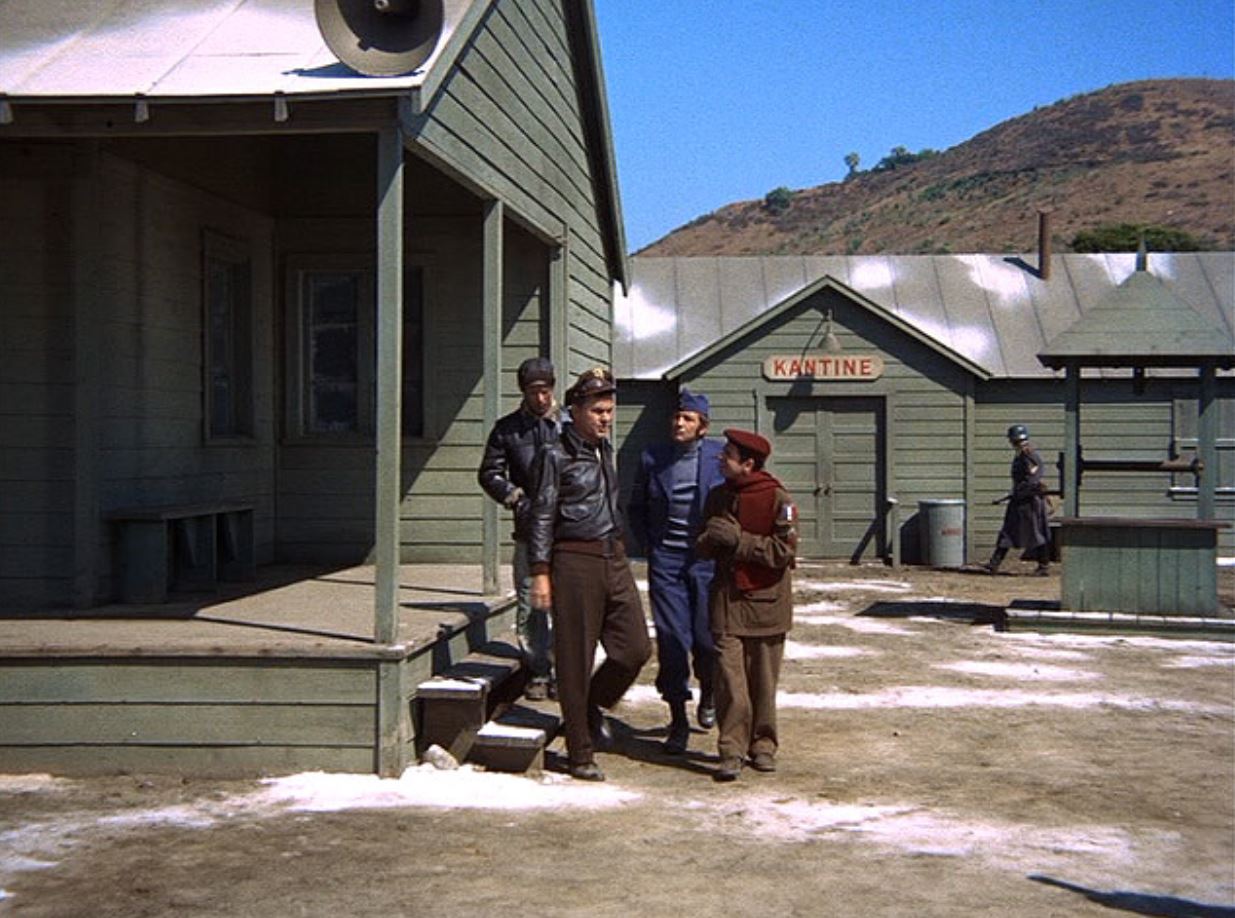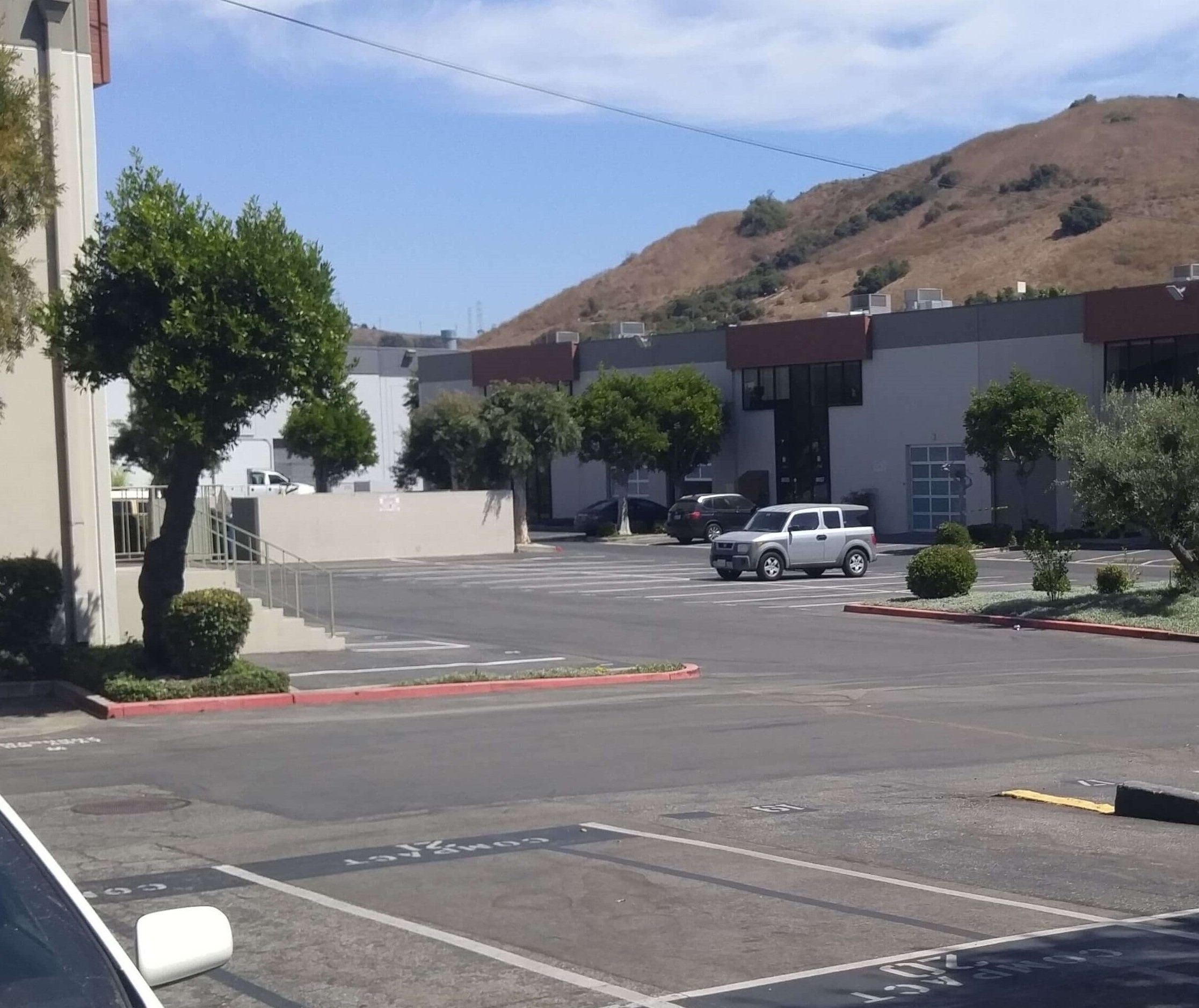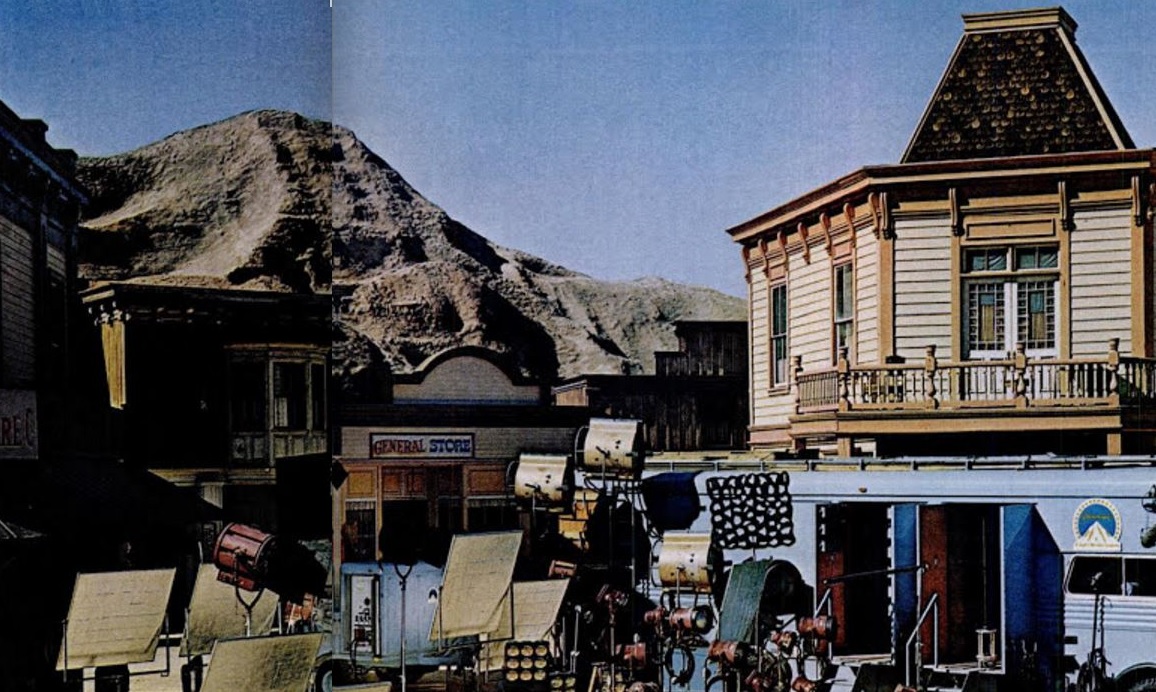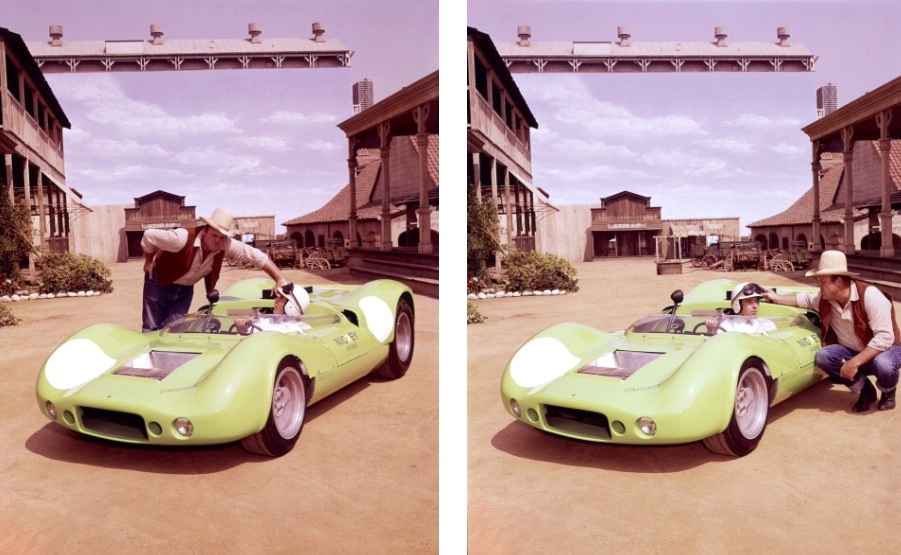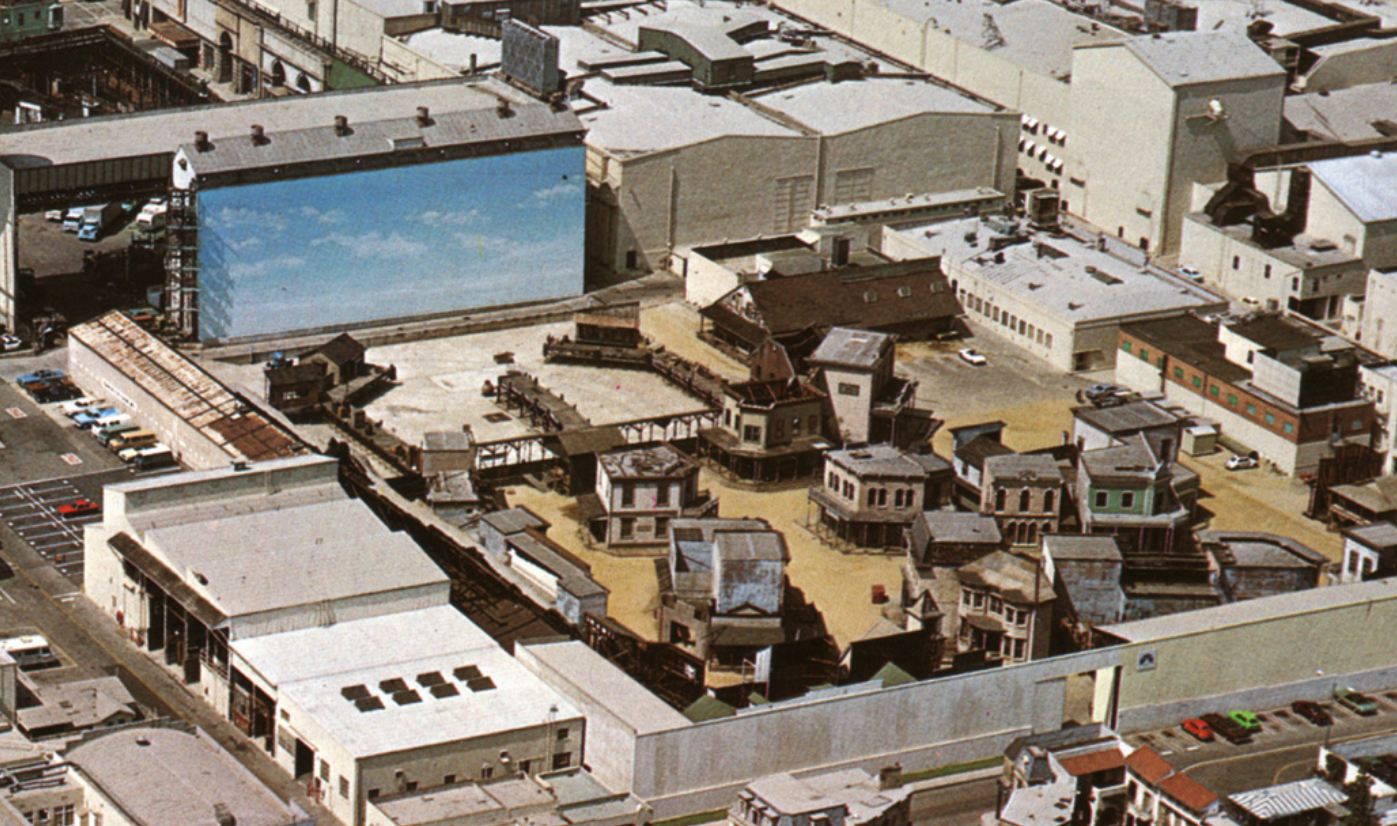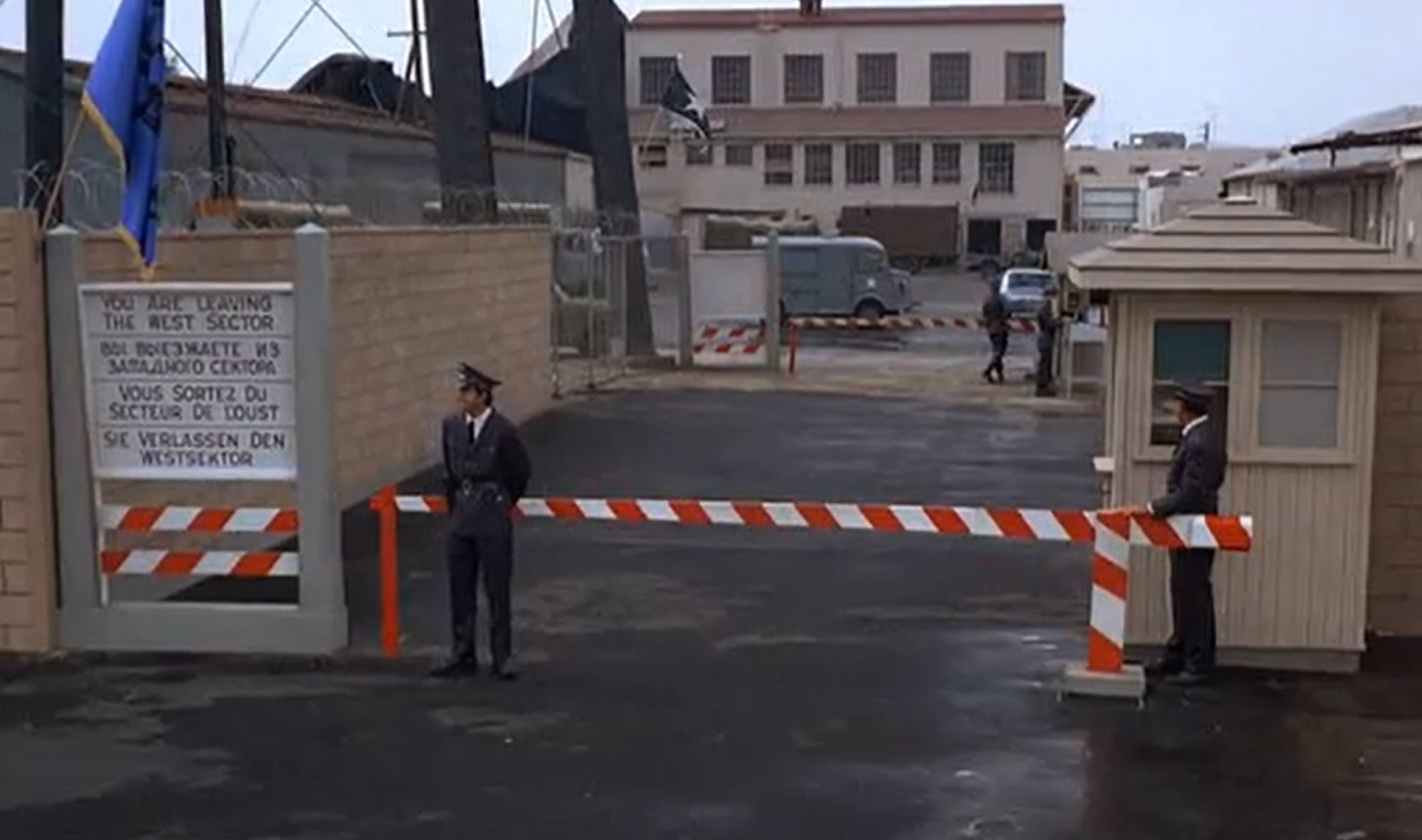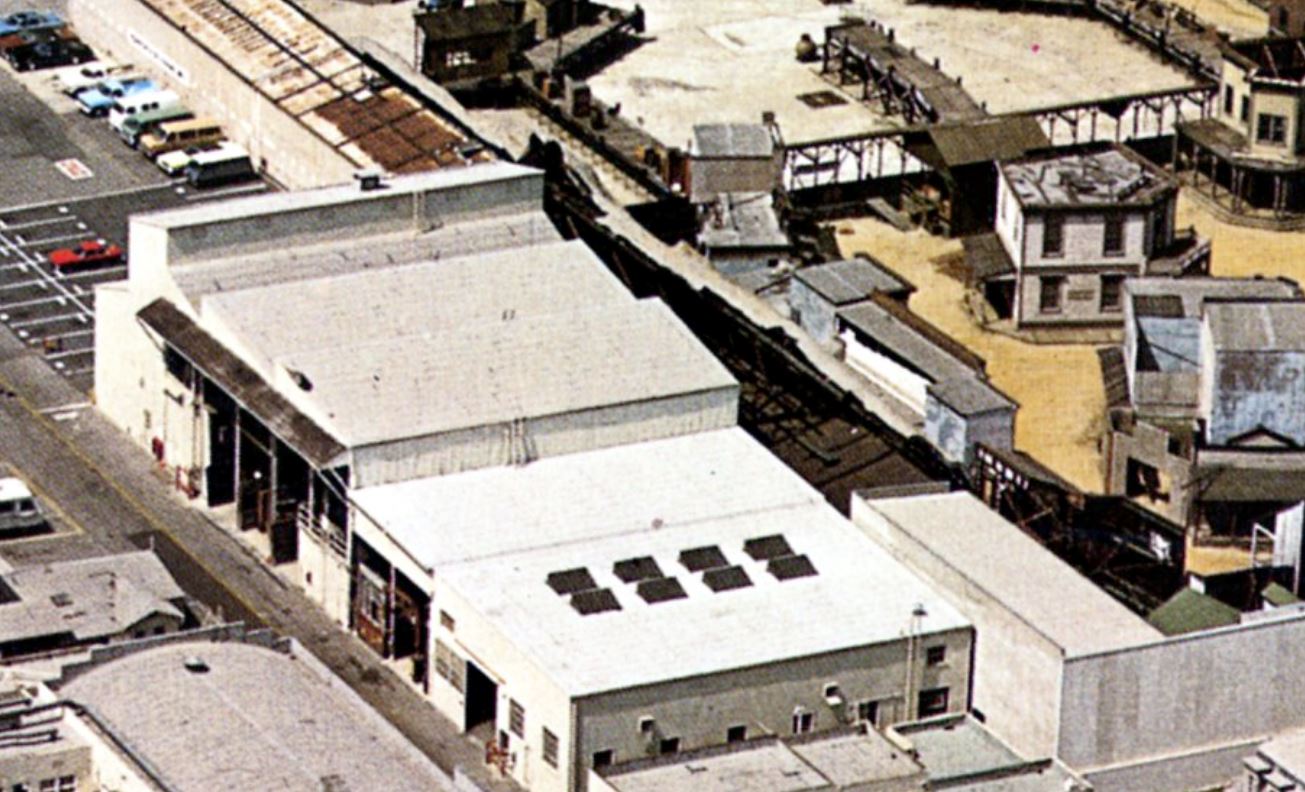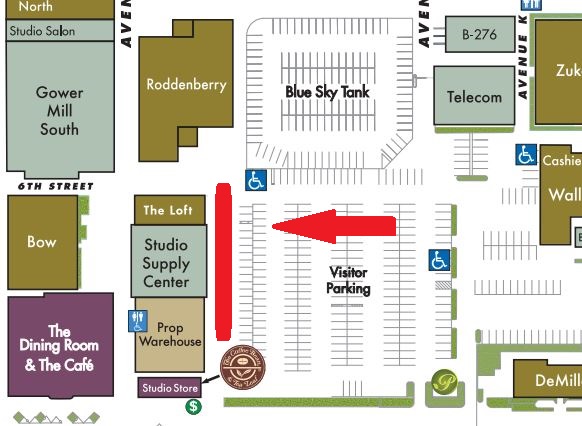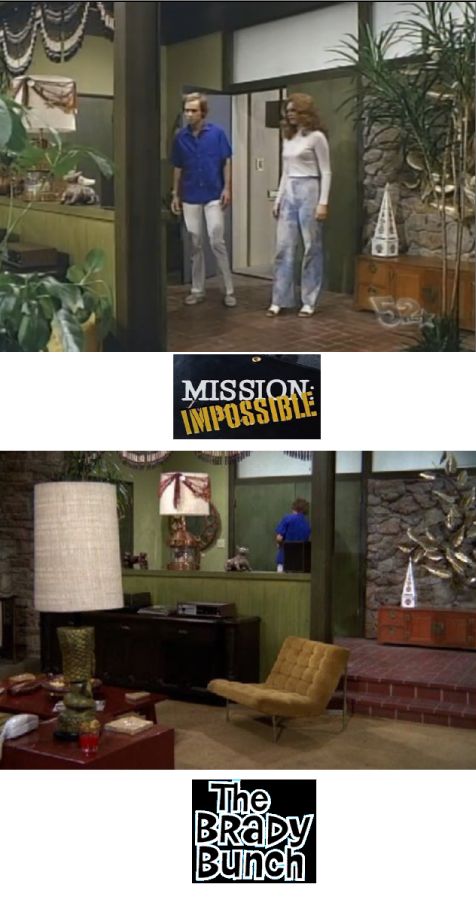The evolution of the TV talk show set only lightly mirrors design changes that were going on in the rest of the world at the time. Plaids, bold colors, African tribal prints, rubber plants–whatever was happening at the world outside migrated into the studio set. But for the most part, these are not meant to be real. They are surreal environments, where everyone sits facing one direction. Where one man has a desk yet no one else does. Where the person in the chair closest to that man’s desk is the favored one, and everyone else is pretty much ignored. This is the world of the TV talk show.
Category: Movie Sets (Interior)
Movie sets typically built on a movie studio’s soundstage.
-
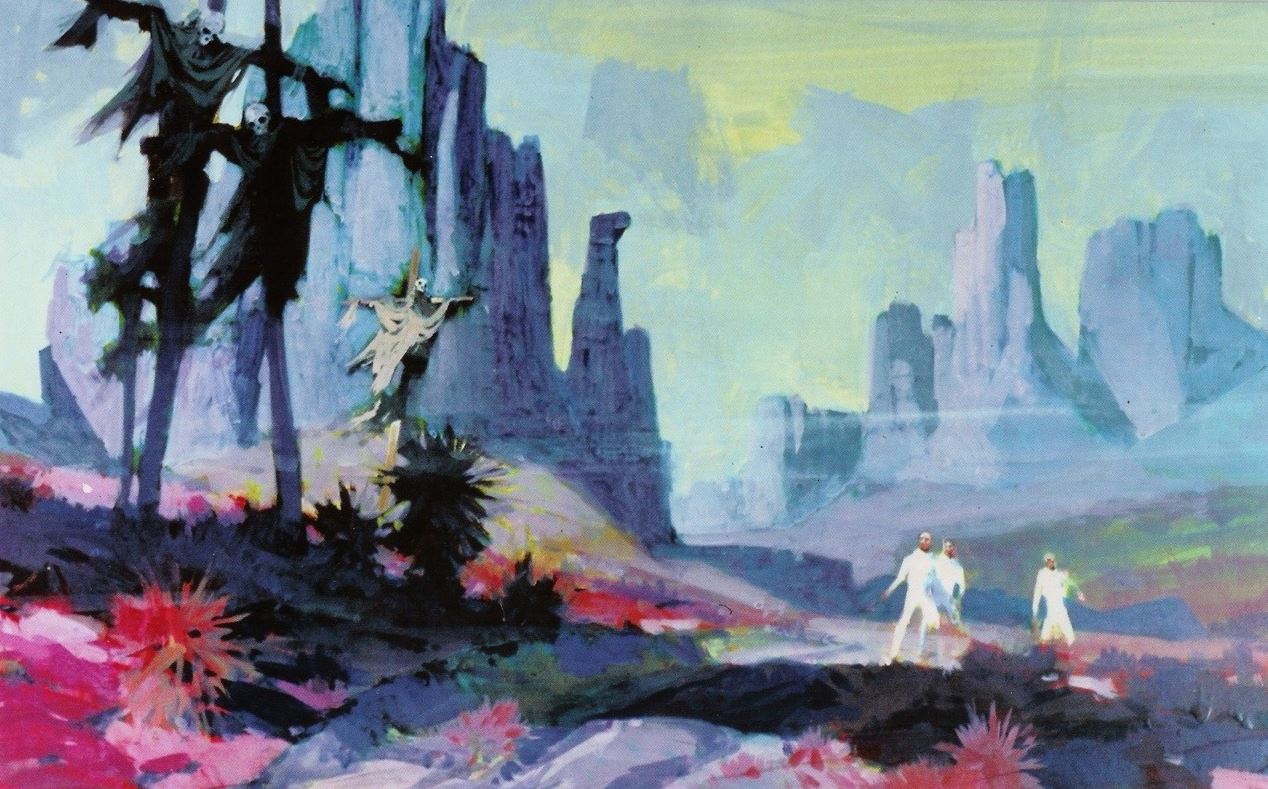
Planet of the Apes (1968) Set Design
Depicting a harsh and dystopian world (at least for the humans), “Planet of the Apes” has become an unlikely film franchise spanning over half a century. The original “Apes” from 1968 has some of the most fantastical, caveman-chic sets of any of the films. Art Directors William Creber and Jack Martin Smith were charged with the difficult task of building an entire futuristic world while limited by the budget of the first in an unknown, untested yet-to-be movie franchise.
Forbidden Zone

Planet of the Apes 1968 Concept Sketch of Forbidden Zone – Mentor Huebner Ape Village
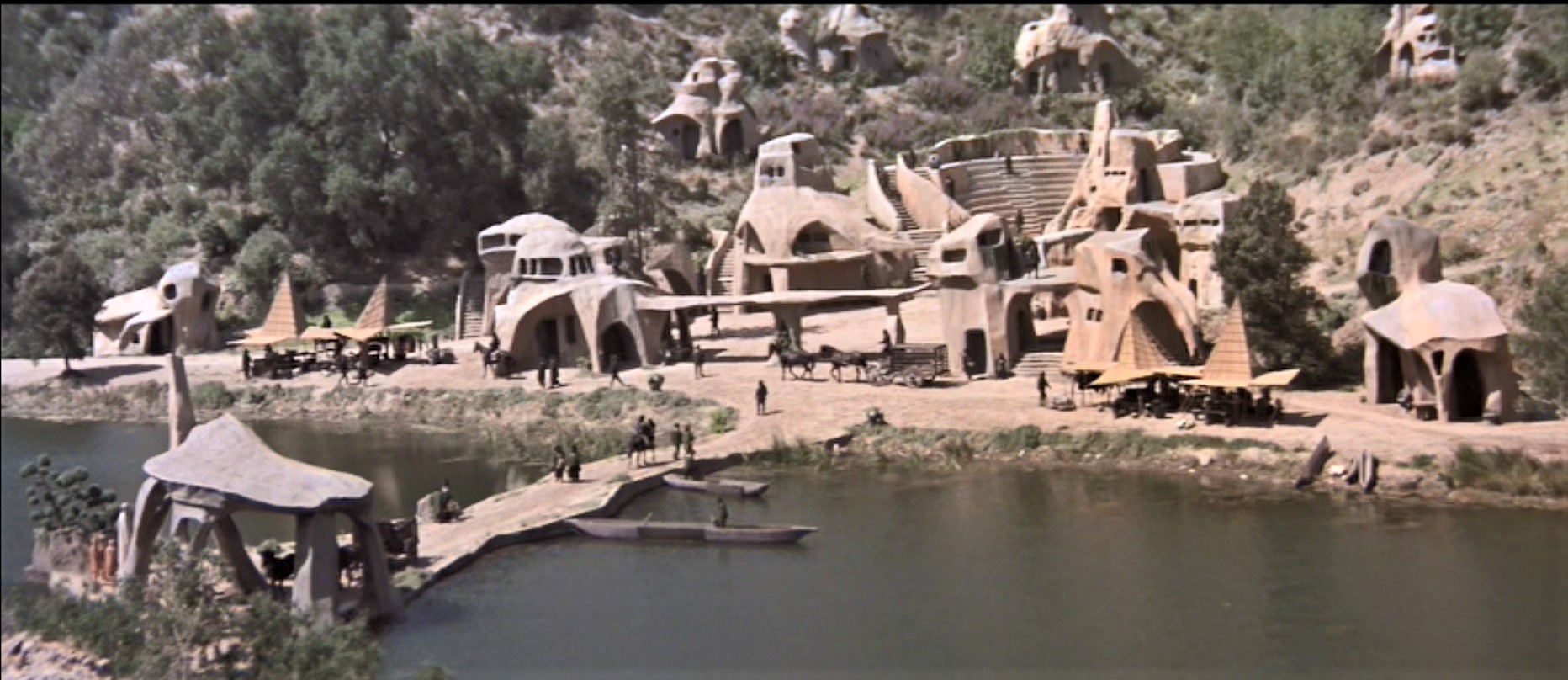
Planet of the Apes Village Set As a result of the film’s lower budget, the centerpiece of the film, Ape Village, was filmed at 20th Century Fox’s movie ranch (now Malibu Creek State Park) less than an hour from its Century City studio. Except for a wide establishing shot (below) that shows just how small the set was, all other shots were kept tight and low by director Franklin J. Schaffner to disguise its tiny stature. Used also for “The Left Hand of God” with Humphrey Bogart the lake was dredged and enlarged by Fox over its early years of ownership.
Concept Sketch of Ape Village
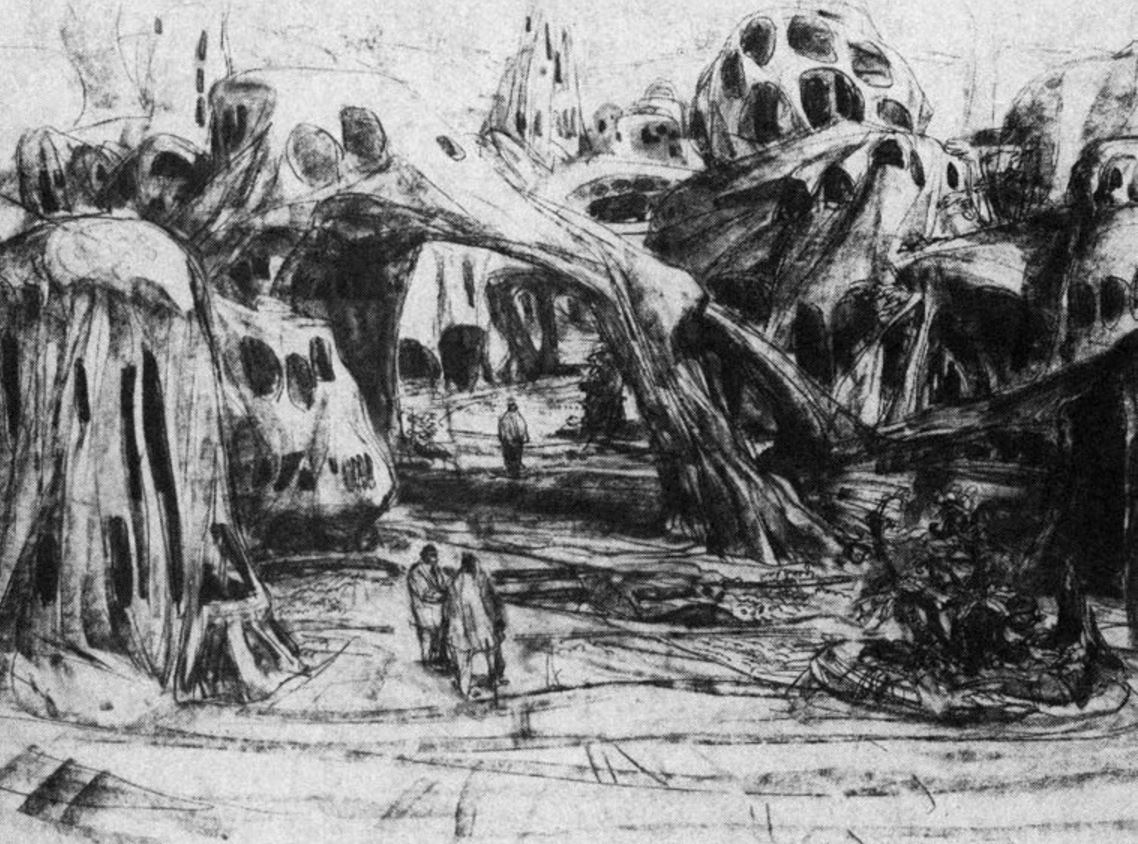
Planet of the Apes 1968 Concept Sketch of Ape Village – Mentor Huebner Mentor Huebner depicted a Gaudi world of craggy, skull-like buildings carved from stone.
Buildings Surrounding the Village
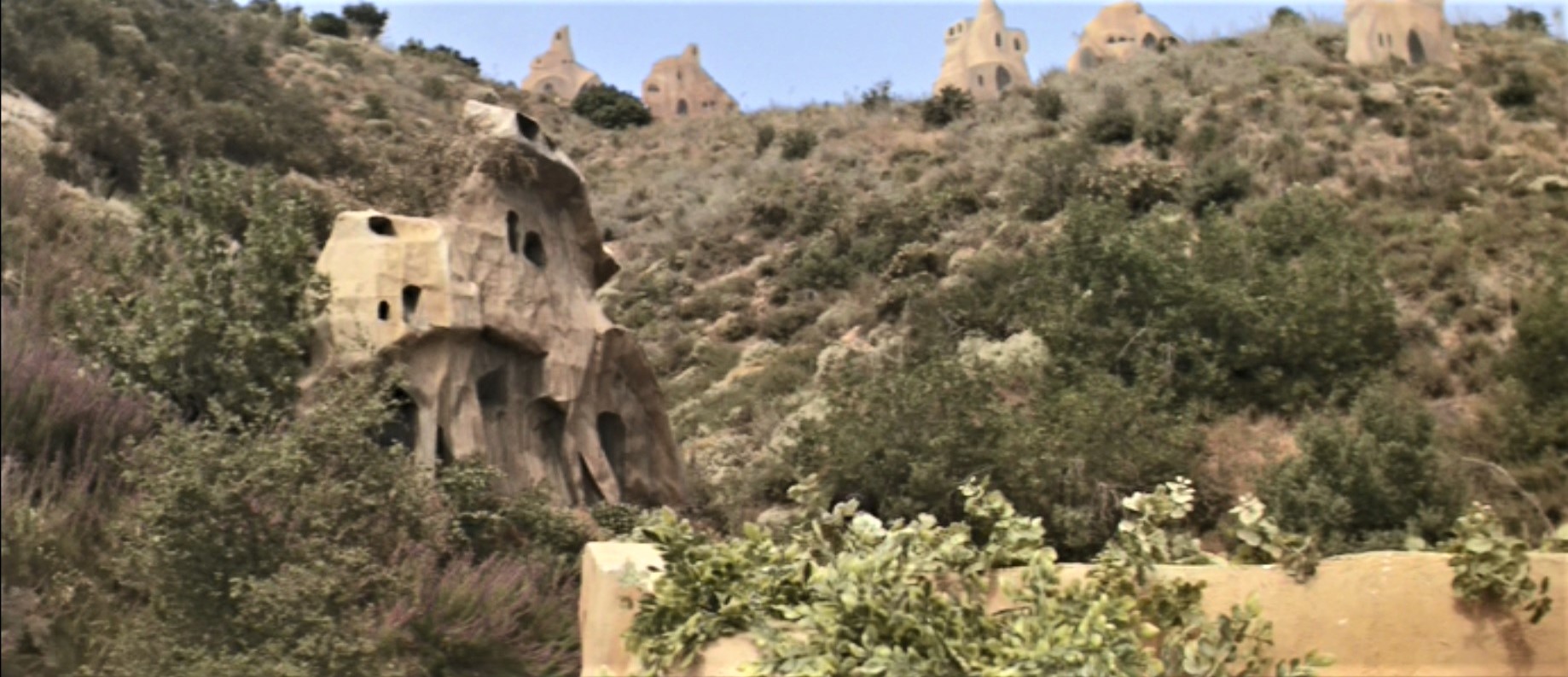
Planet of the Apes Set Surrounding Village To give Ape Village a greater sense of size, additional buildings were constructed on the hills surrounding the town. Forced perspective likely was used to make the buildings look larger and farther away than they really were.
Stone Sky Bridge
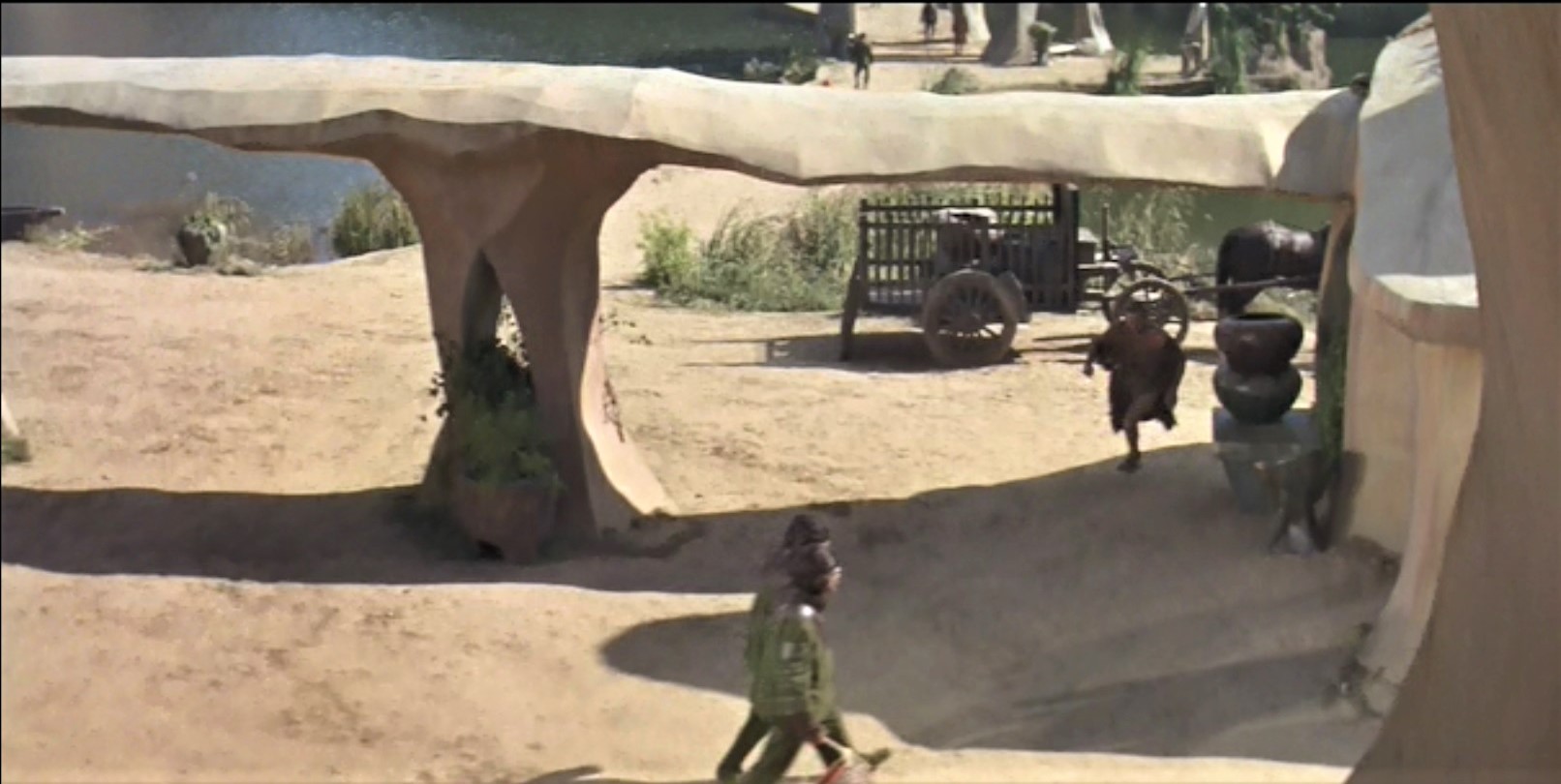
Planet of the Apes Village Bridge Set Amphitheater
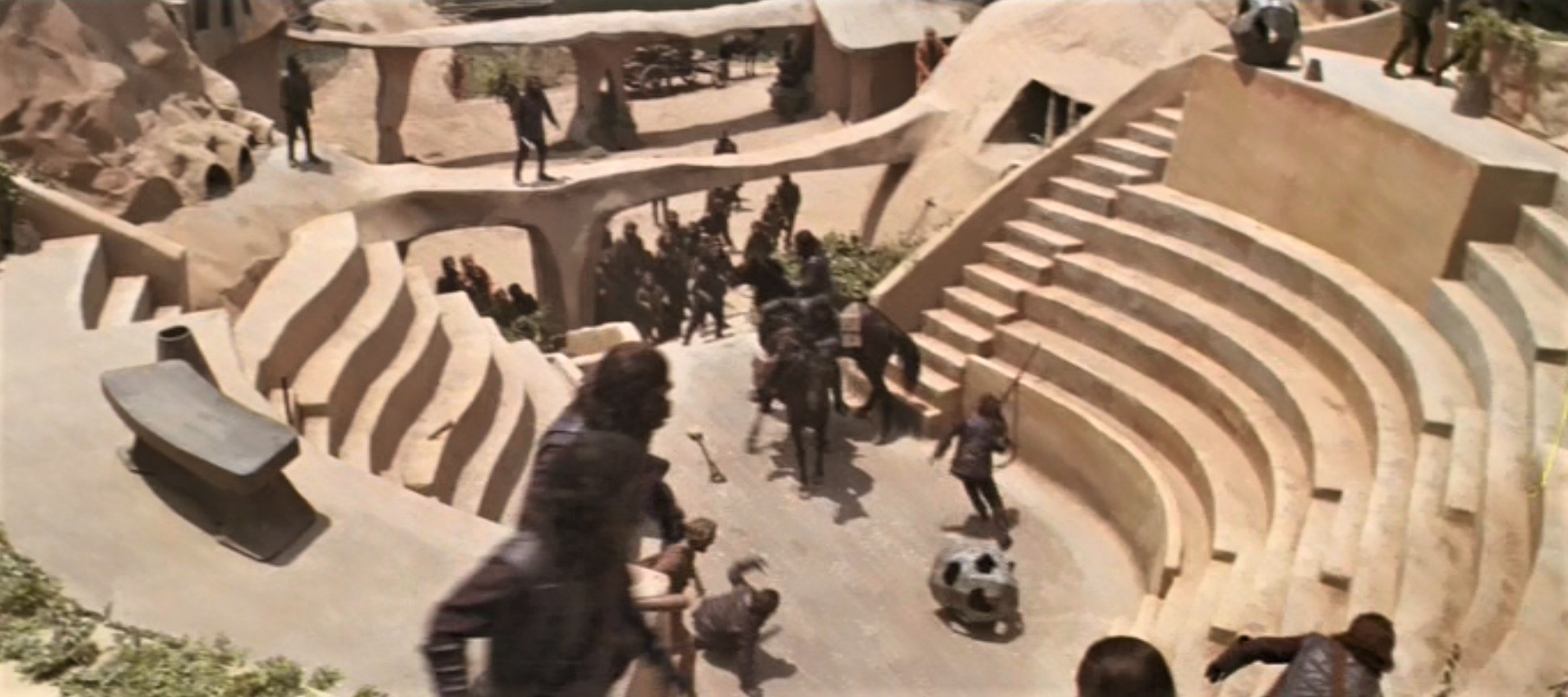
Planet of the Apes Set Amphitheater Church and Unique Circular Room Divider
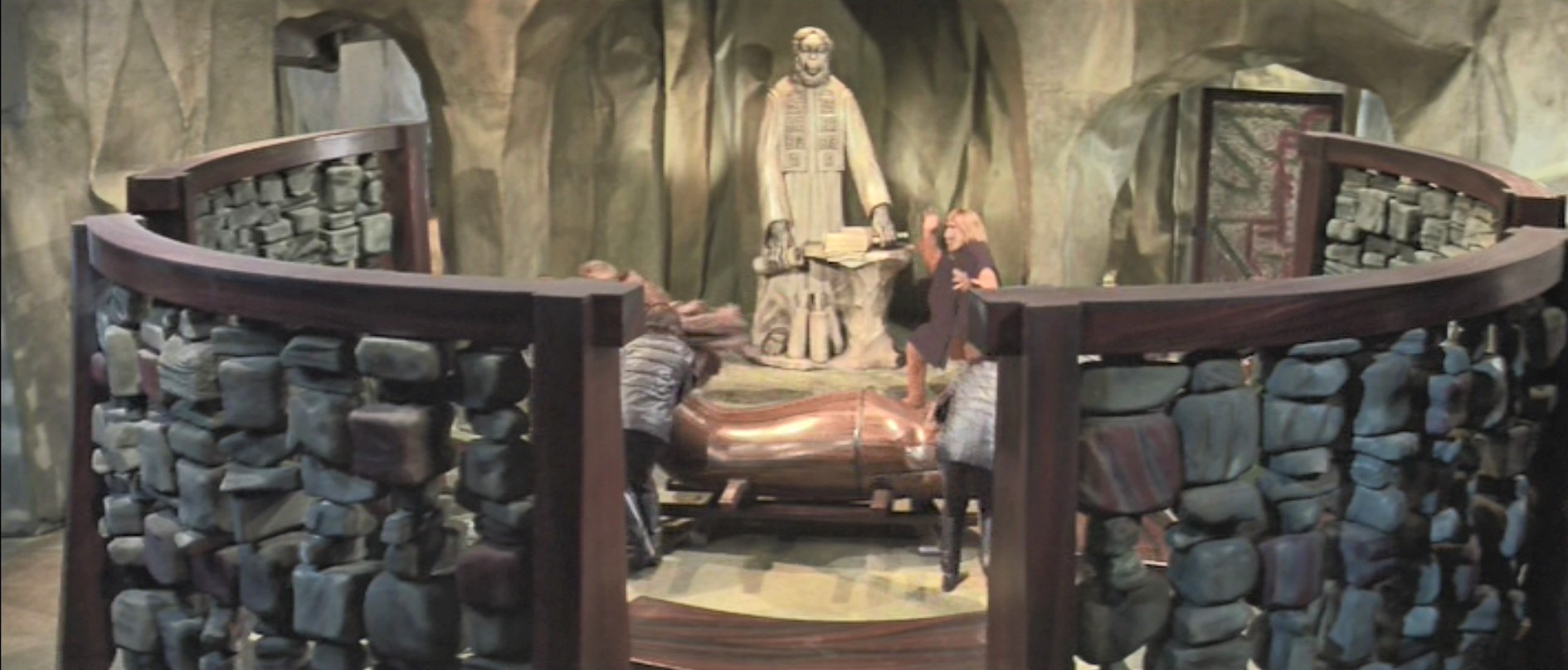
Planet of the Apes Set Church and Circular Room Divider The Apes’ church was enclosed by a semi-circular room divider made of stacked stones.
Museum of Man
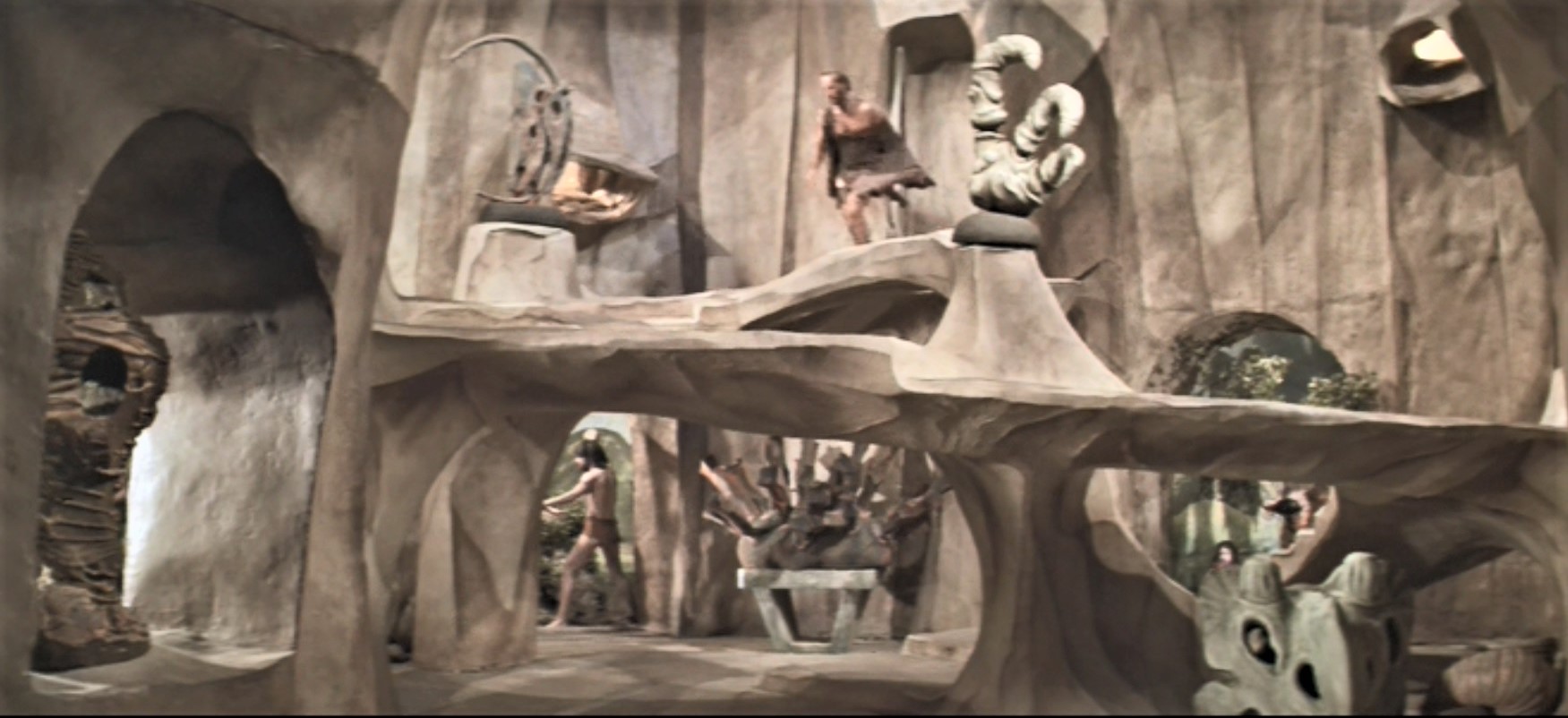
Planet of the Apes Set Museum Interior Hallway
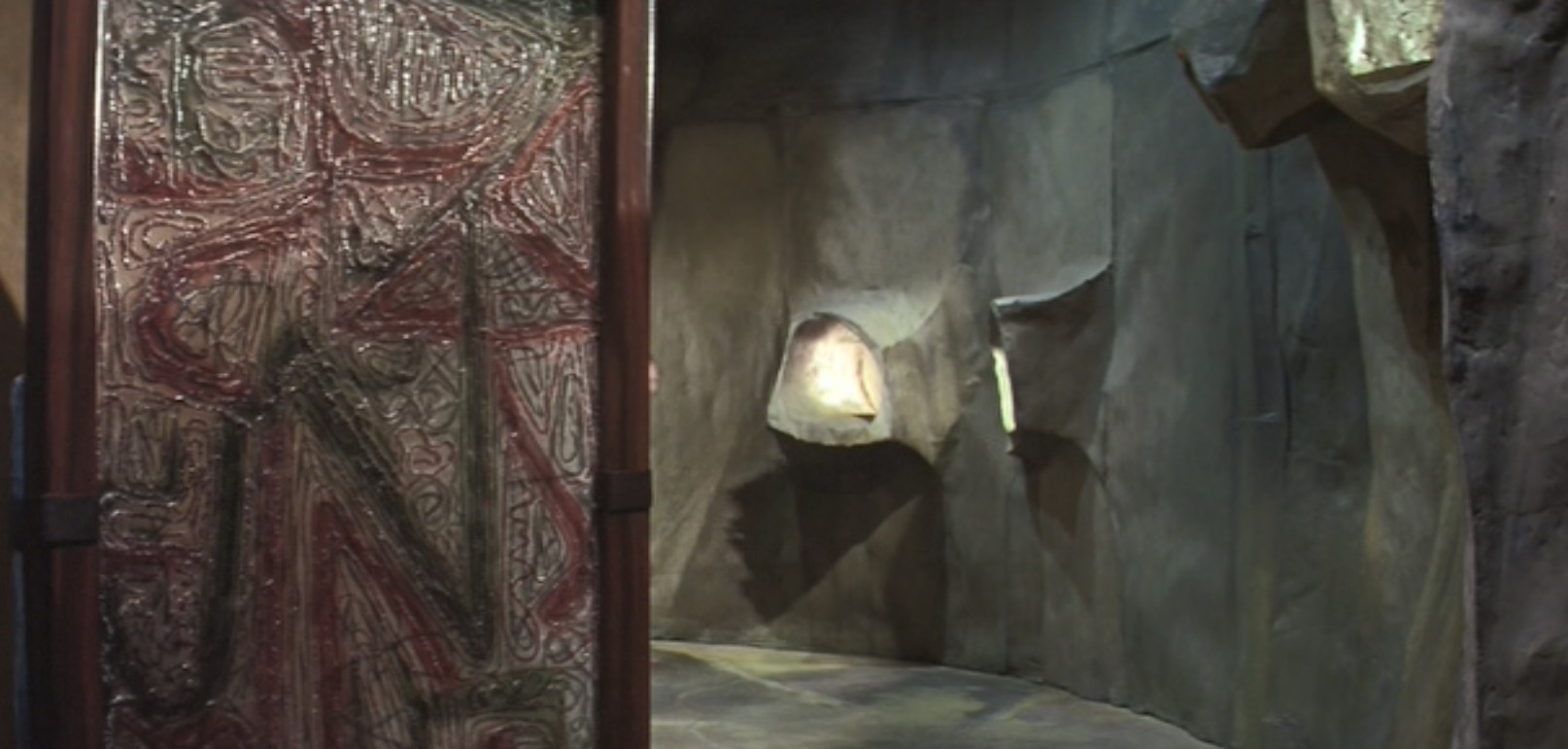
Planet of the Apes Set Hallway Another Hallway
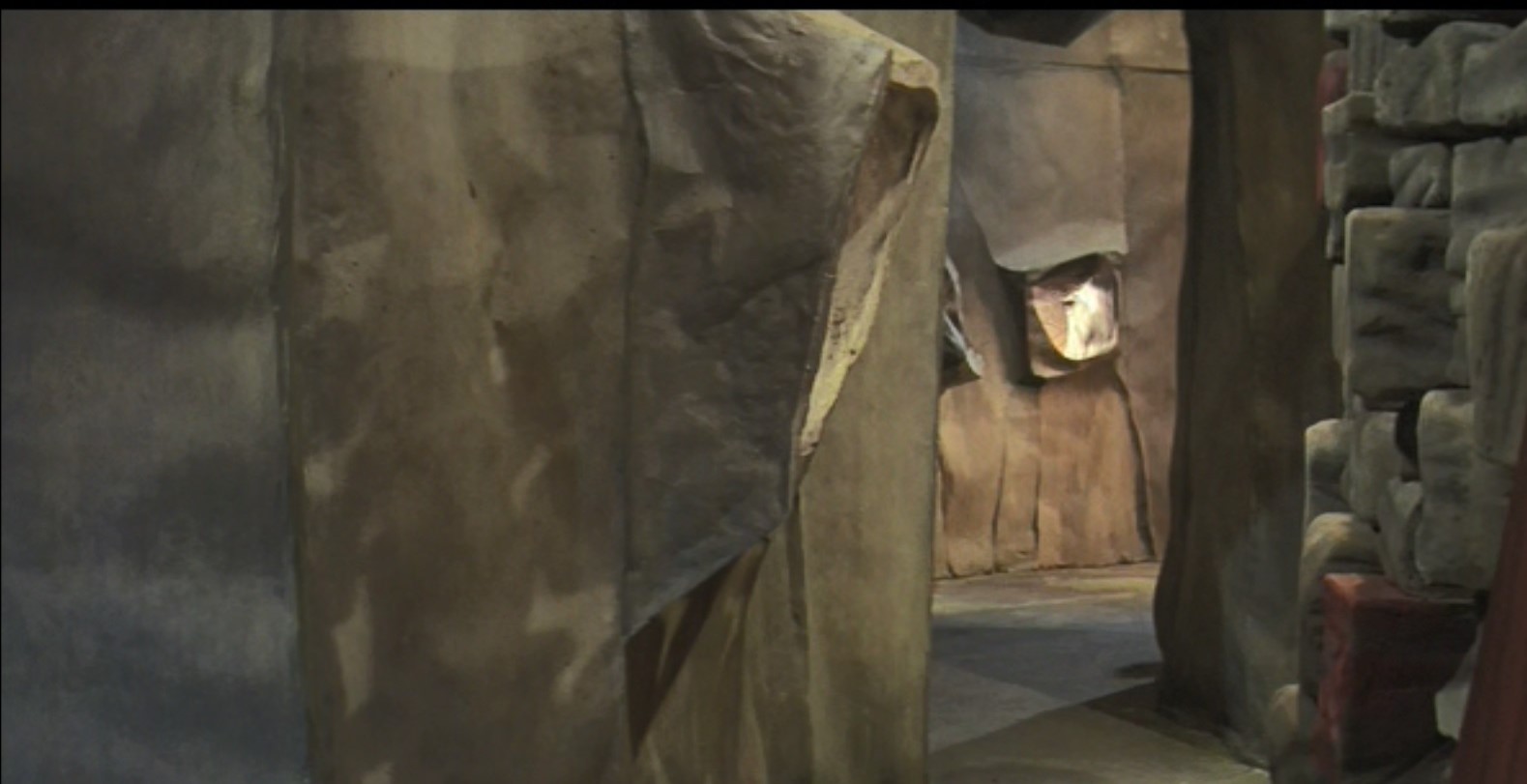
Planet of the Apes Set Hallway Courtroom
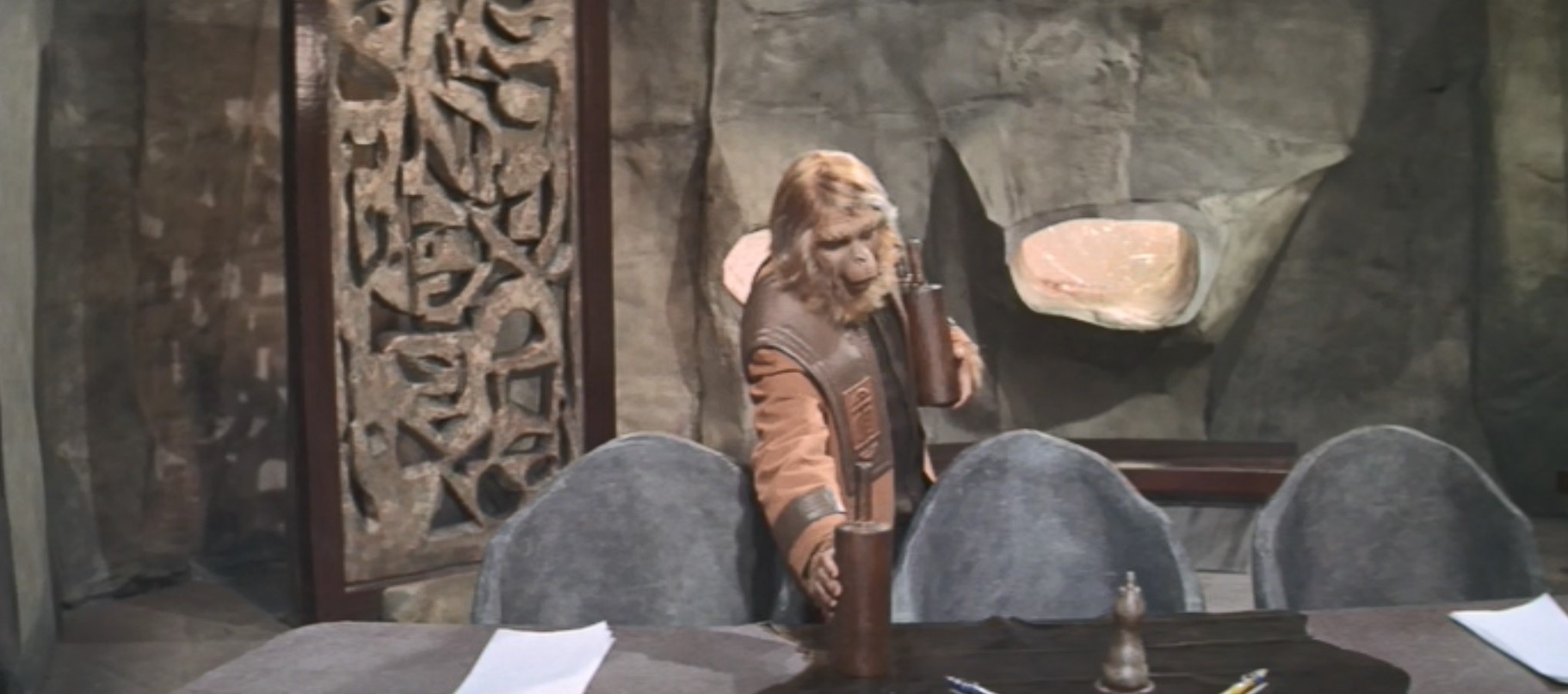
Planet of the Apes Set Courtroom Courtroom Room Divider
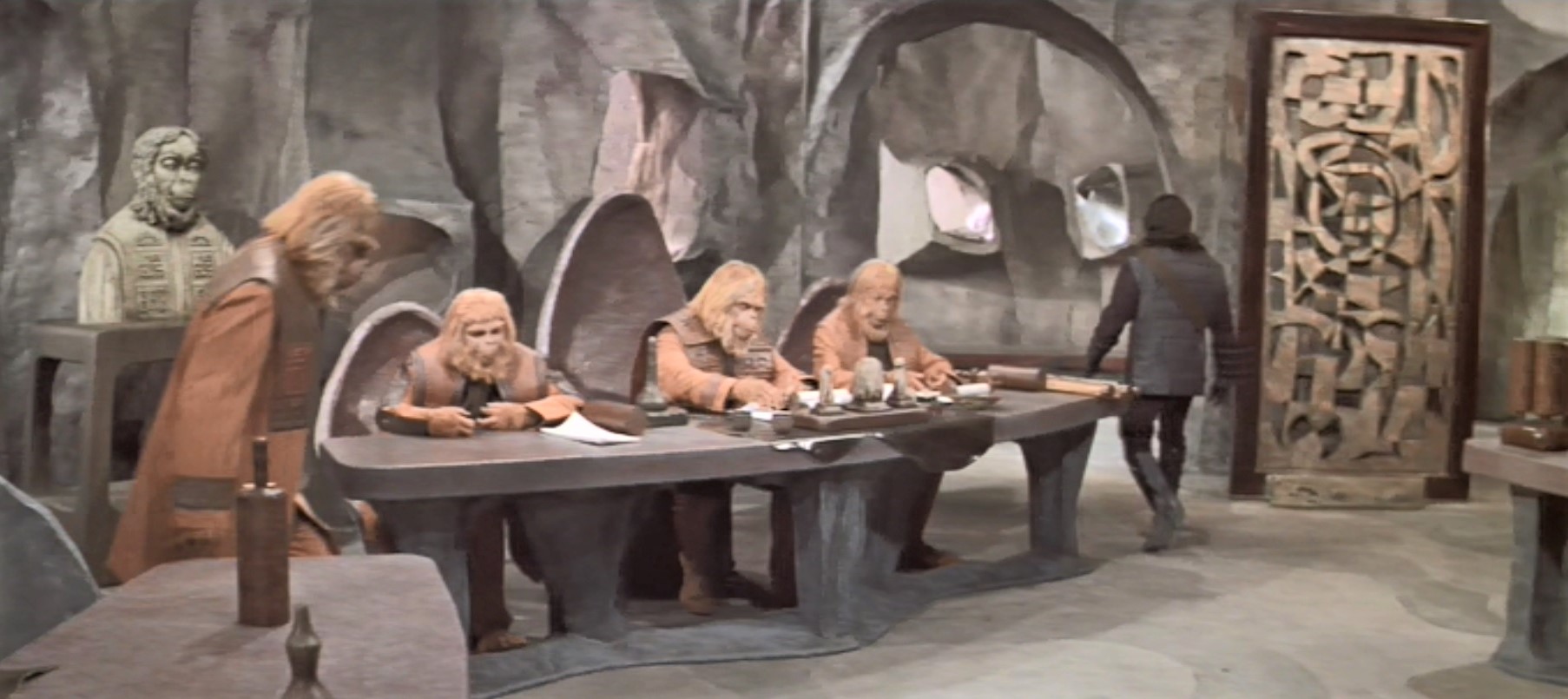
Planet of the Apes 1968 Set Courtroom and Divider 1 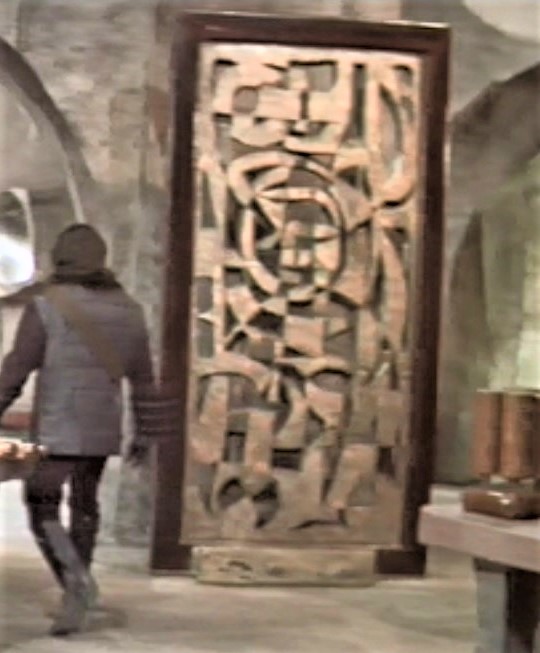
Planet of the Apes 1968 Set Courtroom and Divider 2 Close Up -
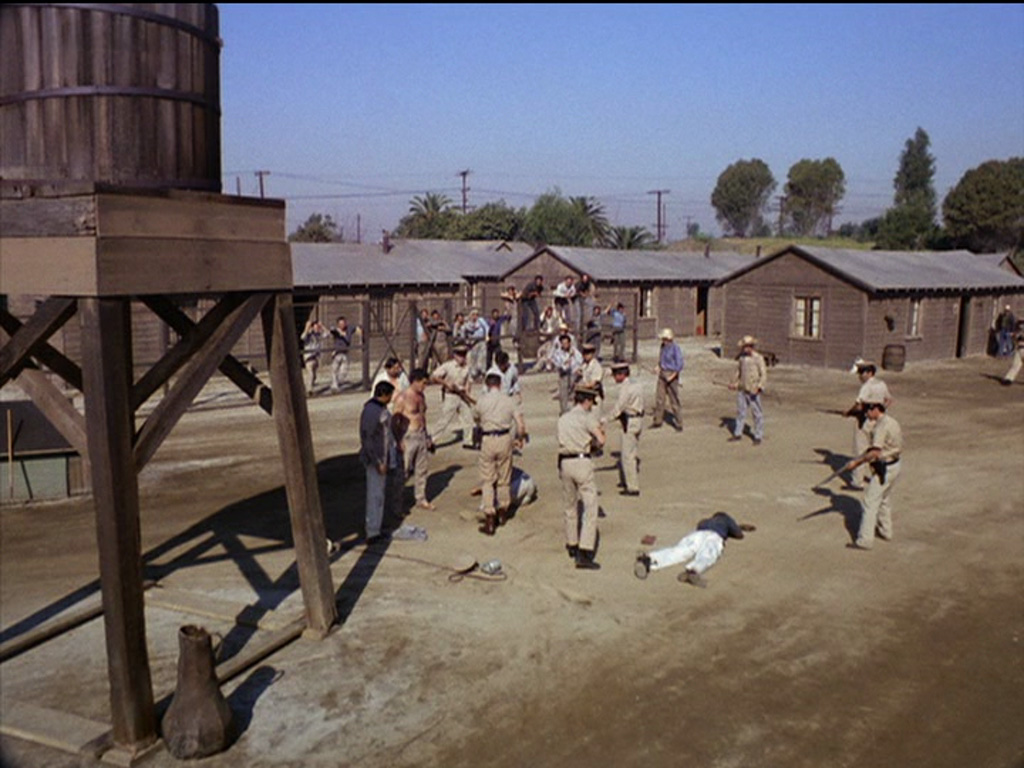
Hogan’s Heroes Set at 40 Acres Backlot: Then and Now
Sure, the Cuningham Group of Culver City, CA-based architects may try to blow smoke in our direction with such slogans as “We exist to Uplift the Human Experience,” but we know better. Back in the Cuningham Group’s past lies the depravities of Nazi Germany–a prisoner of war camp, complete with guard towers, barbed wire, fierce German Shepherds, and cold, barren barracks.
Before the Cuningham Group legal division sends me a cease and desist letter, let it be known that obviously this is sarcasm–you people are beautiful! It’s all a send up of the fact that Cuningham is located on the very location of Stalag 13, the fictional German prisoner of war camp featured in the 1960s TV comedy show Hogan’s Heroes. It’s the old Desilu Culver City 40 acres backlot location.
40 Acres in the Mid-1960s
Today
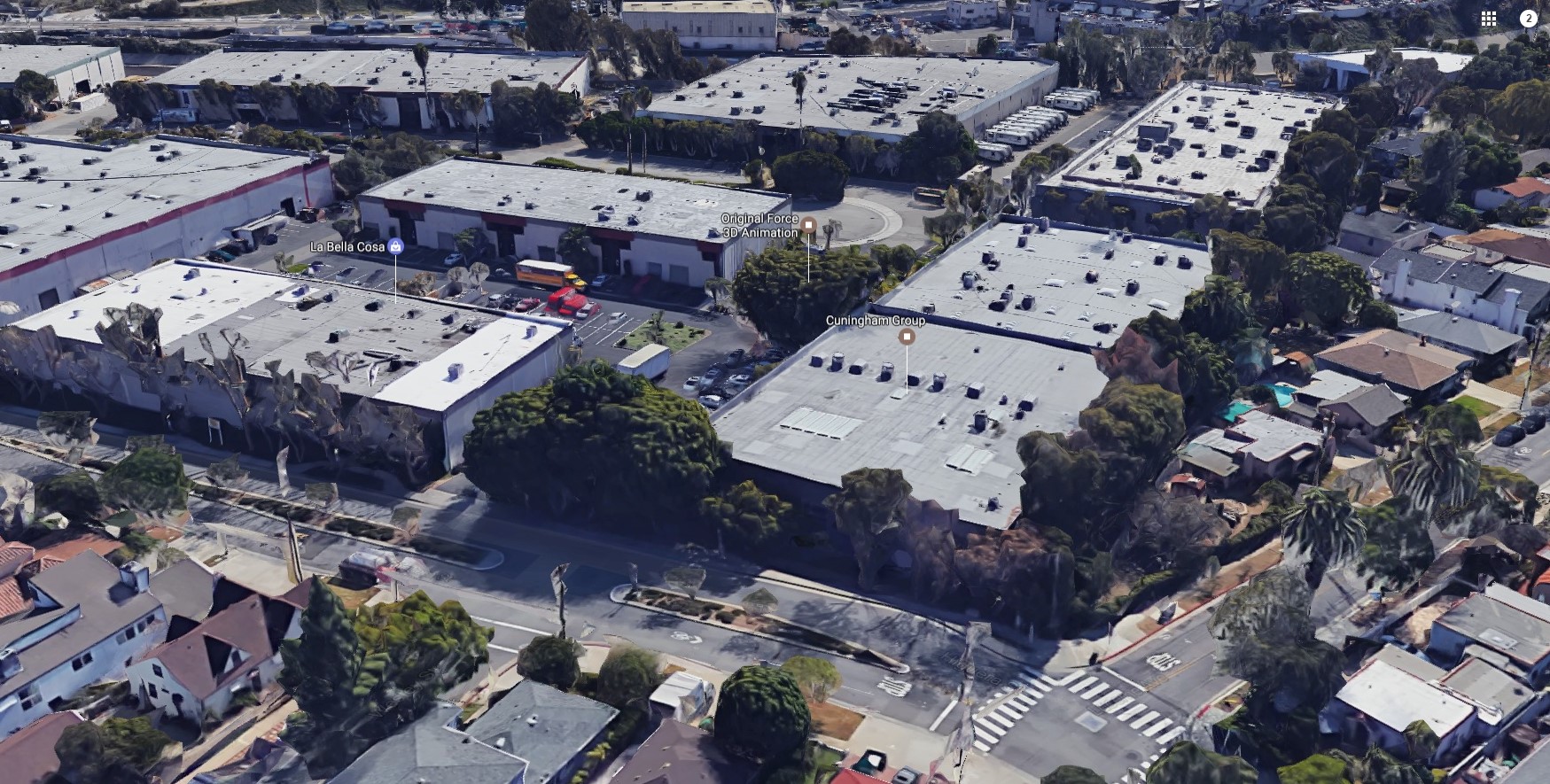
The top photo is of the Desilu 40 Acres Backlot from the mid- to late-1960s. The bottom photo is from Google Maps, 2017, relatively the same angle.
Palm Trees and Power Lines in 1940s Germany
Often during Hogan’s Heroes you will see, in the background, some tell-tale palm trees that let you know that this is not Germany. The best shot I could find is actually from a Mission Impossible episode that used the Stalag 13 set.
In the photo below, we are now in the distance and at ground level. Those palm trees are still there.
Houses in Triangle
The houses in the “triangle” section along Lucerne Street on the right are mainly the same, though changes have been made. Imagine how the residents of those homes in the Sixties felt, having a POW camp just beyond the berm towards their backyard. Gone, too, are the distinctive eucalyptus trees you see in the show, gently waving in the wind.
Slider: 40 Acres Lot 1960s vs. 2019
Stalag 13 View of Baldwin Hills: 1960s vs. 2019
1960s:
2019:
Above is a shot of the Baldwin Hills from the front of the Cuningham Group, summer 2019.
-
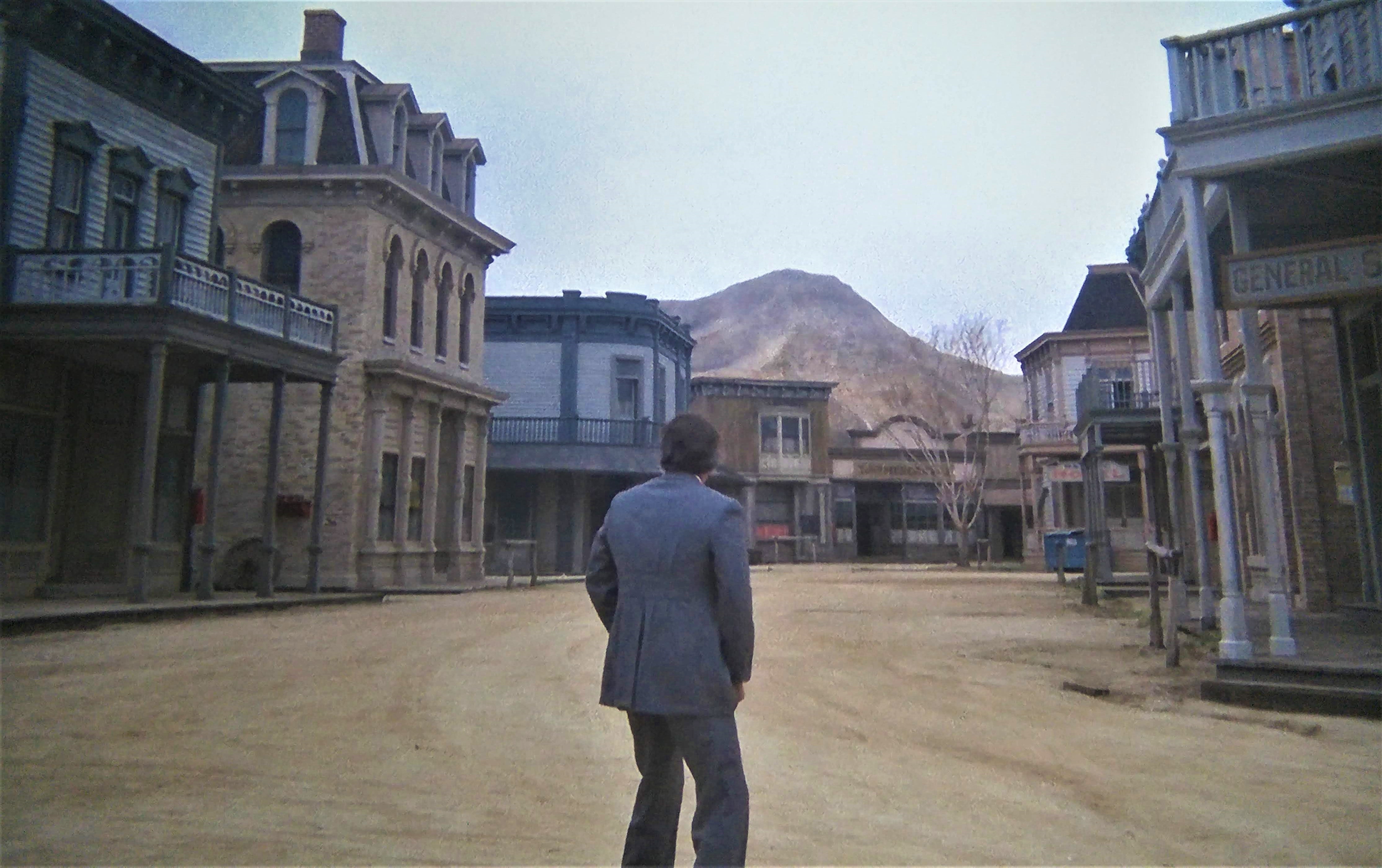
Mountain in the Middle of L.A.: Paramount Studios’ Western Street and Its Fake Mountain
Once there was a mountain in the middle of Los Angeles. Most movie studios, in their backlots or in movie ranches in the San Fernando Valley or in environs close to L.A., had a Western town. It was simply part of the time. Starting with The Squaw Man in 1913 (or The Great Train Robbery, 1903, considered the first Western film), all the way up to the late 1960s, Hollywood pumped out likely thousands of Western full-length features, shorts, and serials. The viewing public could not get enough.
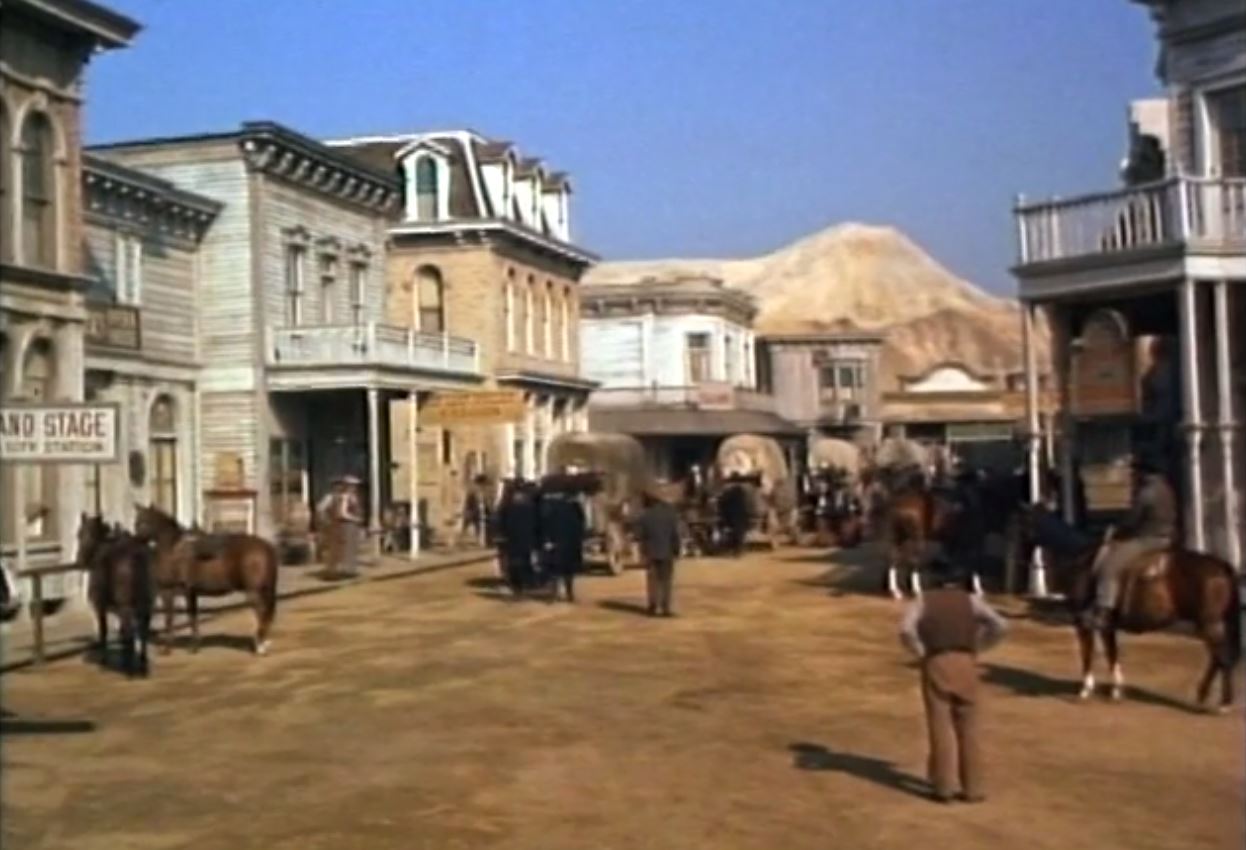
Paramount Studio Mountain in Bonanza, S2/E5 “The Hopefuls” Then, when the 1960s happened, the classic Western fell quickly, deeply out of favor. Westerns were seen as racist, imperialistic, colonialist, bigoted, xenophobic, misogynistic, albeist, sexist, homophobic. And admittedly, it had become a worn-out form. The immediate cure was the anti-Western, with such grotesqueries as Little Big Man, and the ultimate cure was to kill off Westerns altogether. It was time. The old days were over.
Western Street’s Mountain Backdrop
One victim of Paramount’s Western town pull-out was the scaled-down mountain backdrop behind Paramount’s Western town. Steven Bingen, in his excellent Paramount: City of Dreams, tells us that this mountain went up in 1955 and was constructed of chicken wire and plaster. It was a three-dimensional backdrop of sorts, though not with much dimension. As seen in those of the aerial photos below, the mountain was a fairly thin sliver covering up a warehouse.
For a rare glimpse at the mountain’s super-structure, check out Jerry Schneider’s Movie Locations Plus page on Paramount. This image shows that the mountain was almost like a flat cut-out with some texture that has been tilted back about 40 degrees.
Bingen continues to say that initially a painted backdrop of a cloudy blue sky was erected behind the mountain, “similar to the B-tank backdrop,” but this proved unnecessary because of Los Angeles’ already cloudy blue skies. (B-tank is a massive 914,023 water tank with a backing that measures 175’6″ wide by 61′ high.)
Accounts from people who worked at Paramount in the 1970s say that, by the late Seventies, the mountain was already looking decrepit, before it was finally torn down.
1957
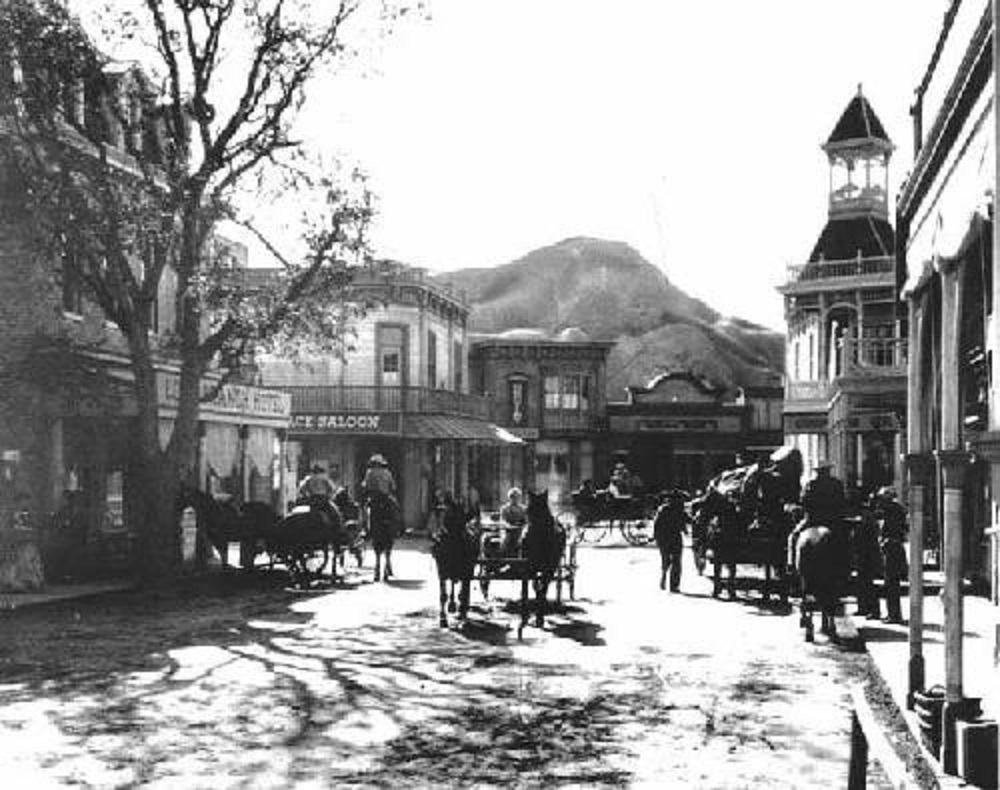
The Tin Star, with Henry Fonda and Anthony Perkins, 1957 1960
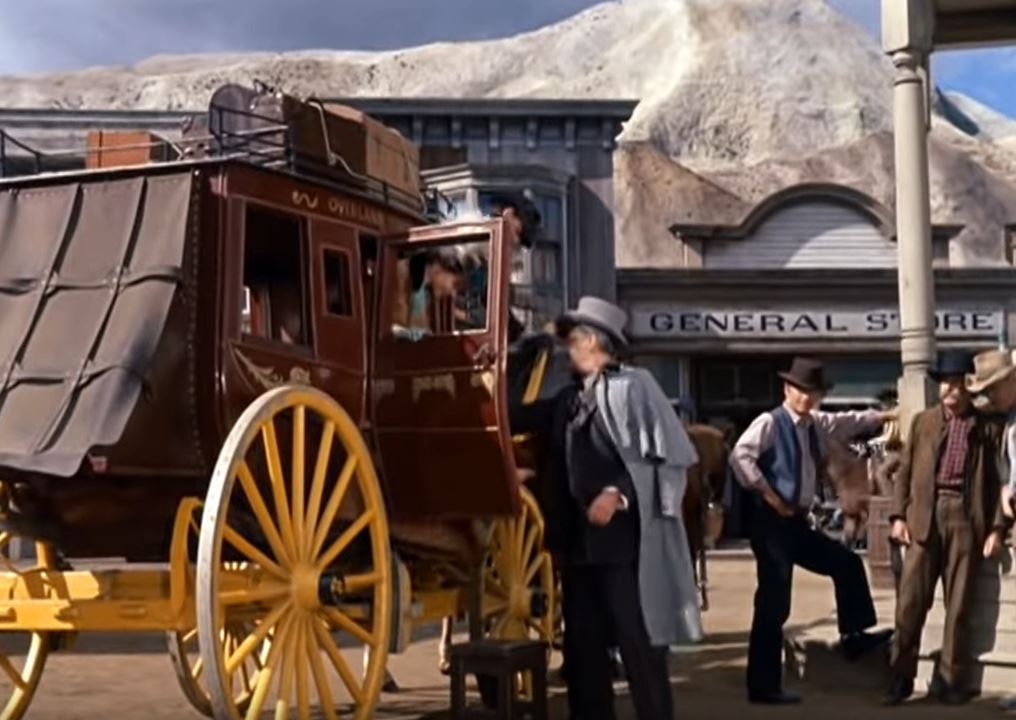
Bonanza – The Last Trophy – March 26, 1960 – Season 1, Episode 27 Above, a good close shot of the Paramount mountain from Bonanza.
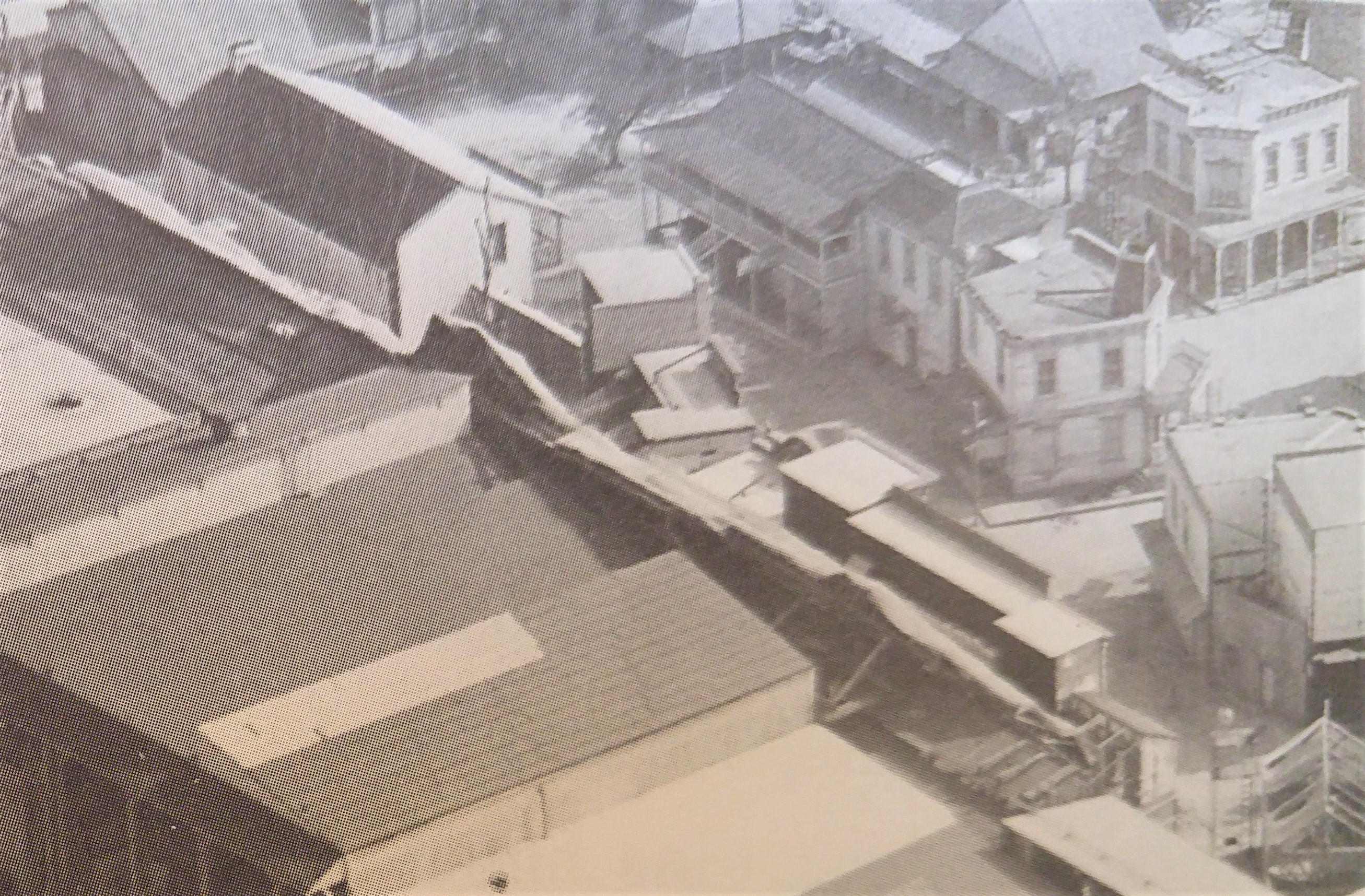
This is a tight close-up of the backside of the mountain in 1960. Due to the angle of the shot, the mountain’s size is almost impossible to detect. The first image in this article, the one with all of the movie-making equipment laid out, was taken around the upper-right side of the photo, pointing leftward. That was one of the favored angles for many TV shows and movies to come.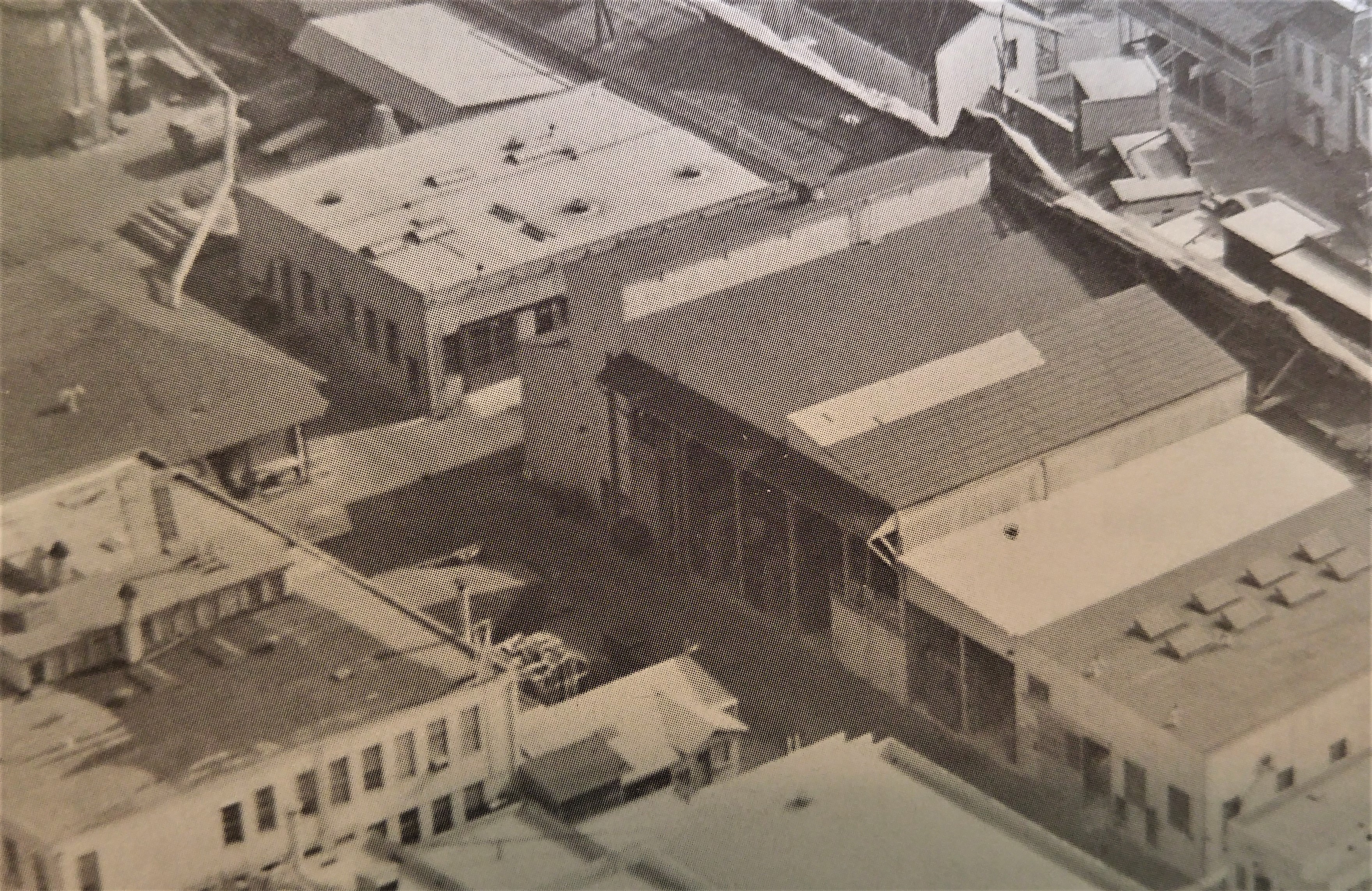
A close-up of the above photo. The area in the upper-left is where the Mission Impossible scene referenced later was filmed.1961
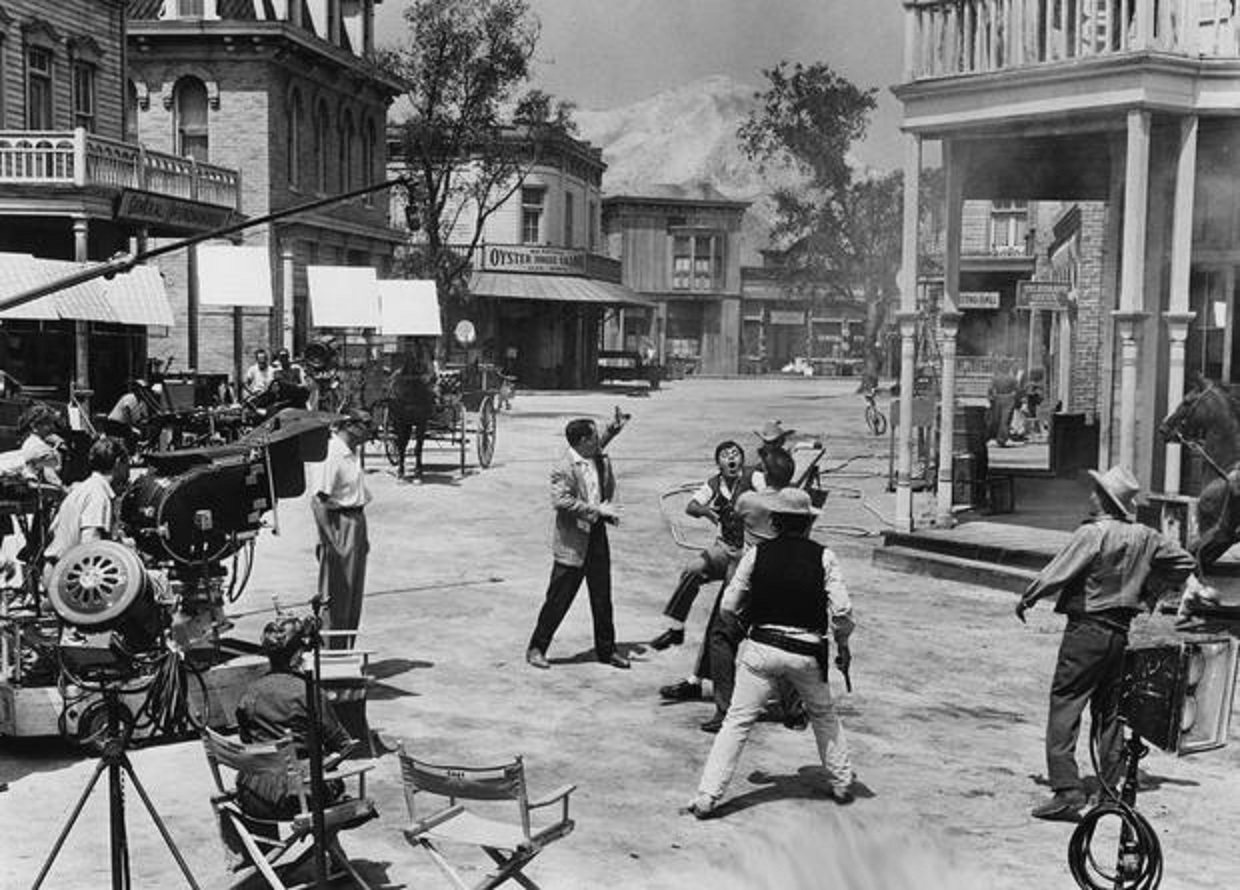
Paramount Western Street – Jerry Lewis Errand Boy, 1961 1966
Obviously, this is not the mountain but a sightline down a different Paramount Western street toward B-tank and its sky. This shows the type of building roof (though higher) that the Western mountain was covering. It’s also a good demonstration of how well the backdrop’s blue matches the L.A. sky. Above is Bonanza actor Dan Blocker with the sports car he owned named the Vinegaroon and driver John Cannon.
In the aerial view of the Western set below, the Blocker photo is taken diagonally. Imagine a line in an 11 o’clock position, and that’s the direction of the Blocker photo. The mountain would be at a roughly 8 to 9 o’clock position.
1968
In the Mission Impossible TV series, S3/E12 (“The Exchange”), for the 1968-1969 season, you can see the back of the mountain. The actors Barbara Bain and John Vernon are behind the mountain, starting at the base of the iconic Paramount water tower. The edge of the mountain can be seen in the upper-left. In the next two images, they advance:
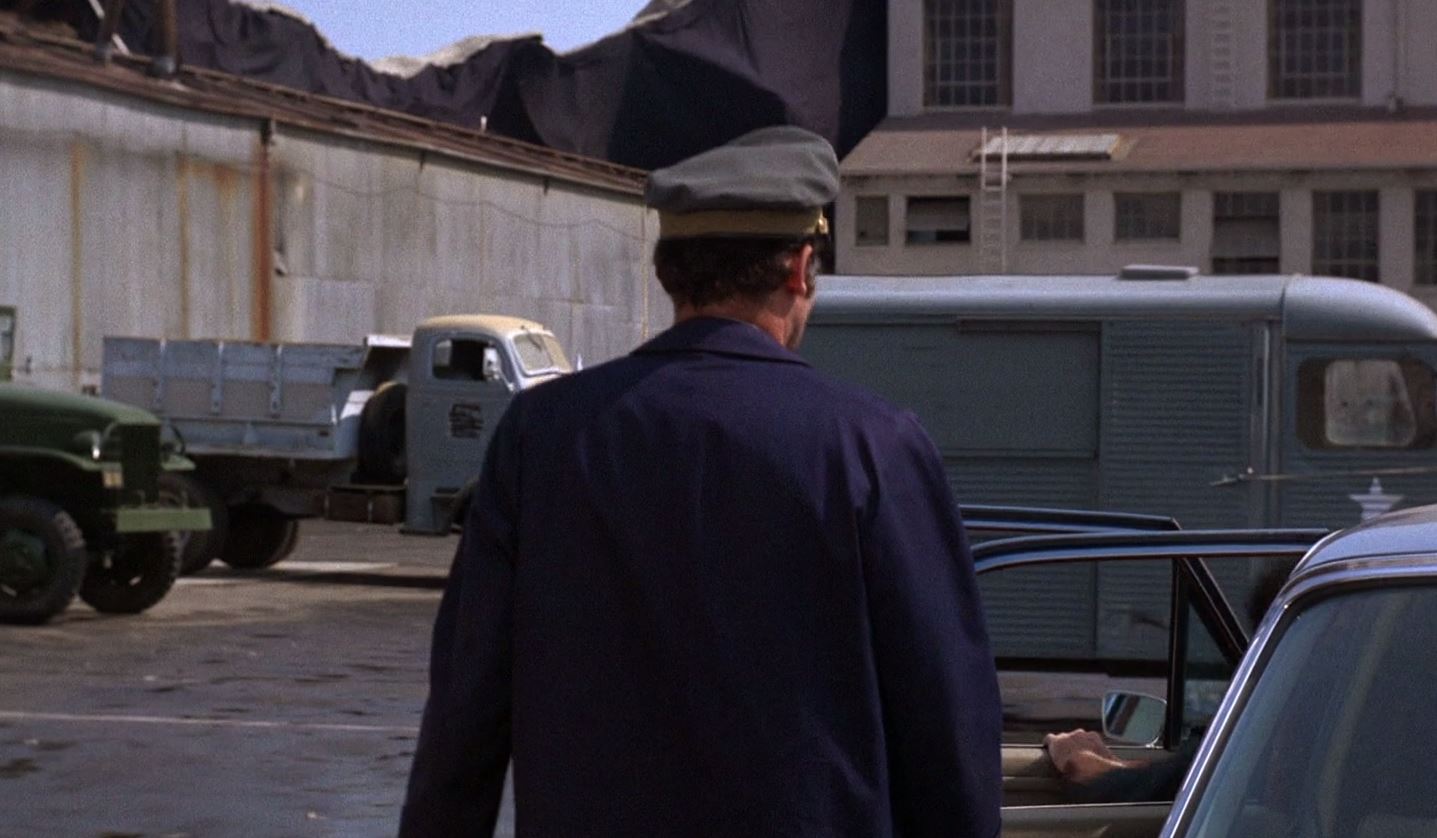
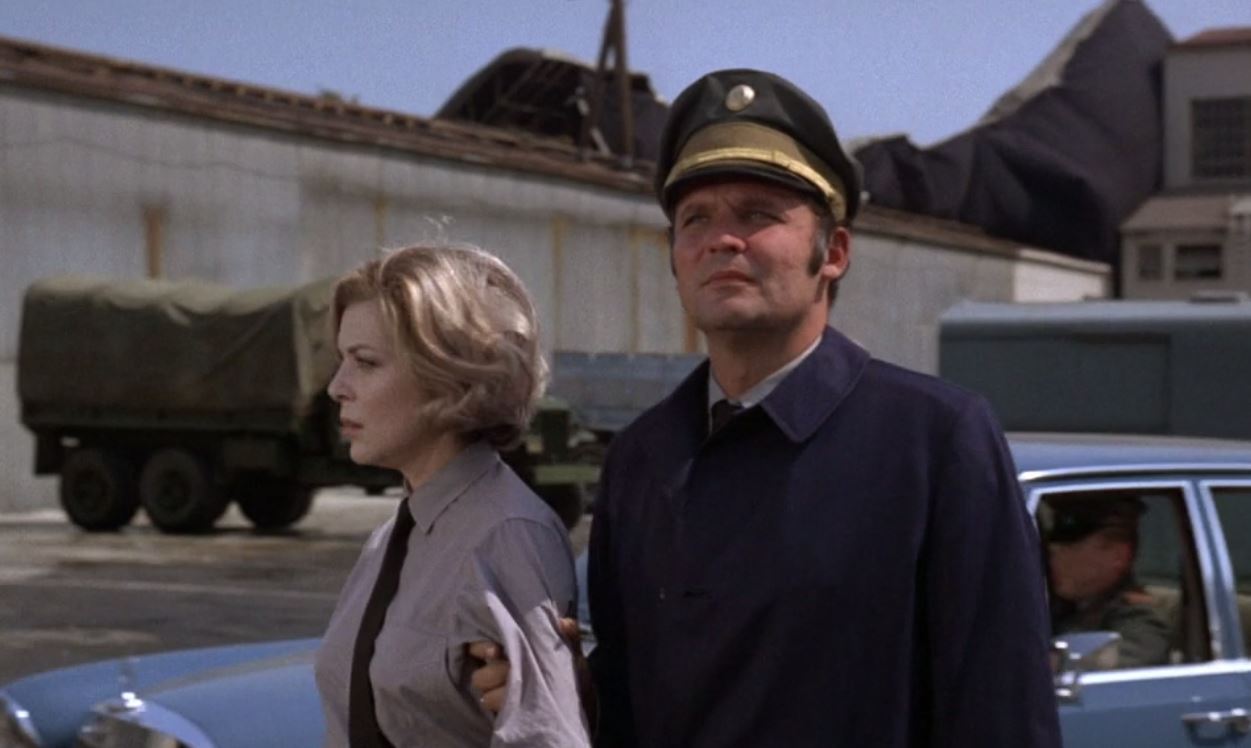
1971
From “Mission Impossible,” Season 6, Episode 2, “Encore.” William Shatner stumbles onto a Western set at the fictional Majestic Studios, which is actually the Western section of Paramount Studios’ backlot.
1971
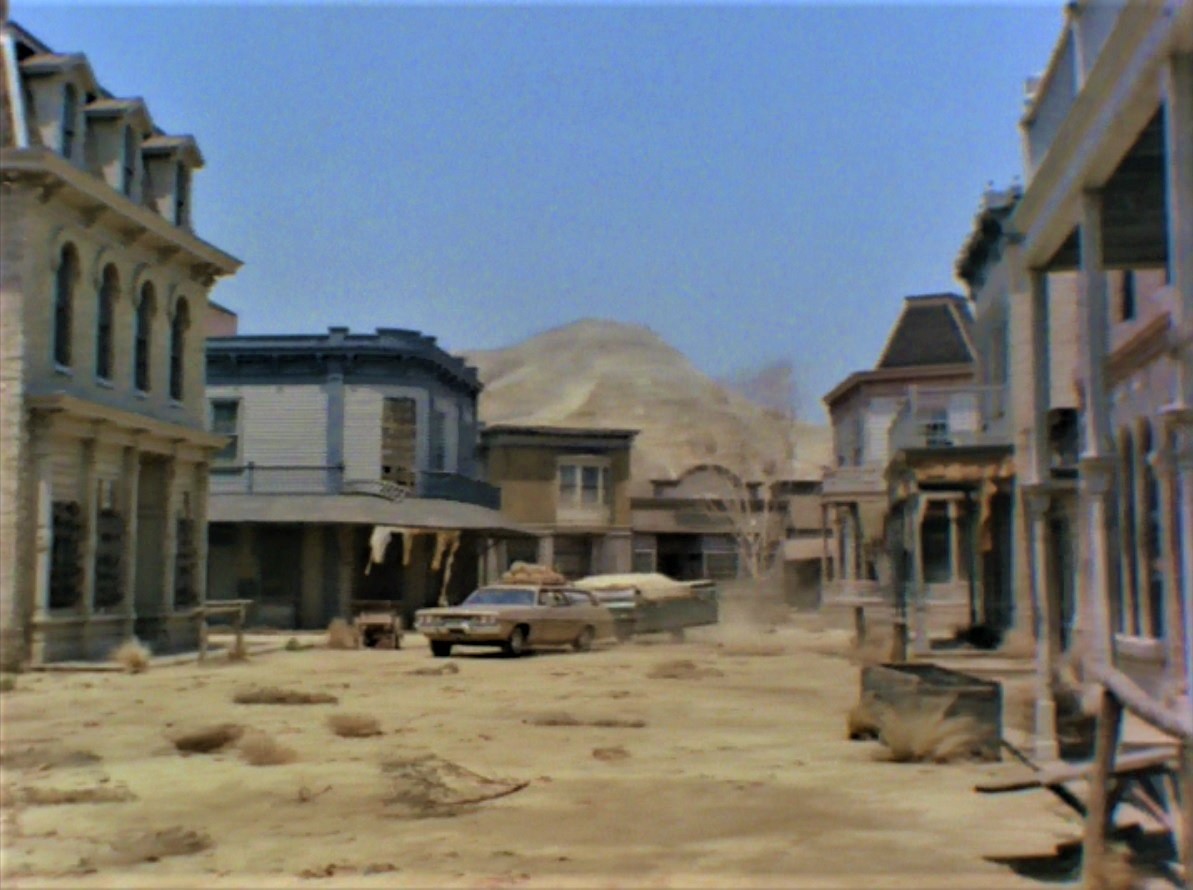
Brady Bunch Paramount Mountain Ghost Town USA, 1971 That favorite blended family of 1970s television, The Brady Bunch, found themselves in the shadow of the Paramount mountain in 1971’s “Ghost Town U.S.A.”
1976
The last photo of Paramount Mountain, 1976, roughly the same angle as the 1960 image.
1982
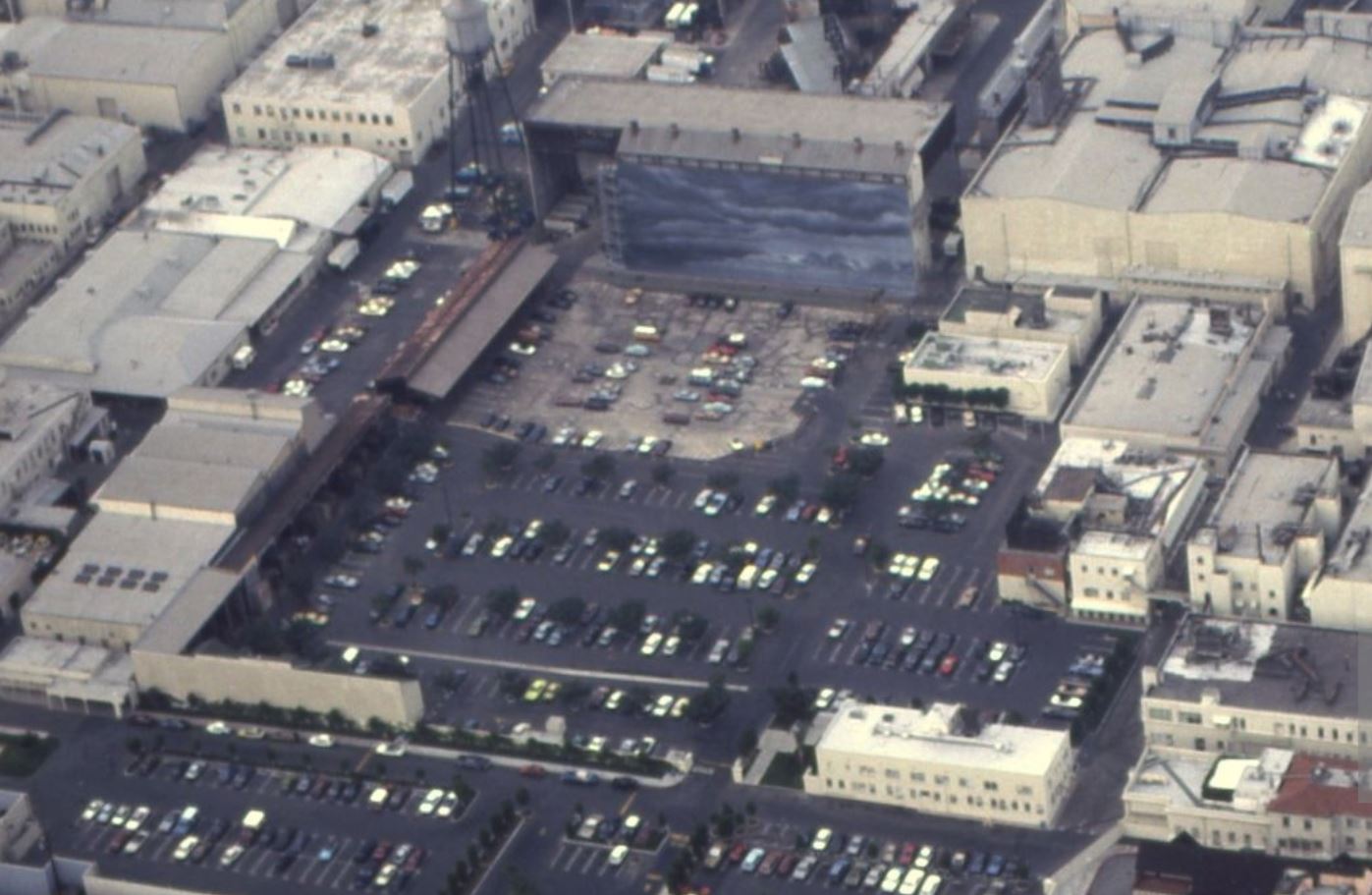
Paramount Pictures Aerial Facing North, 1982 By September 1979, the entire Western street had been bulldozed away to make way for the parking lot. In 1982, nothing was left.
Today: Location of the Mountain
Today, the mountain is long gone. In the above map, the missing mountain is shown as a red strip and indicated by the arrow. It would have been to the side of the larger Visitor Parking near the Blue Sky Tank Parking. The structure housing the Prop Warehouse, Studio Supply Center, and The Loft replaces the previous building.
In fact, the Paramount tour takes you directly under or at least very near to the mountain. After the stop at the Prop Warehouse, you walk north on a walkway, then take a right to walk between the two parking lots.
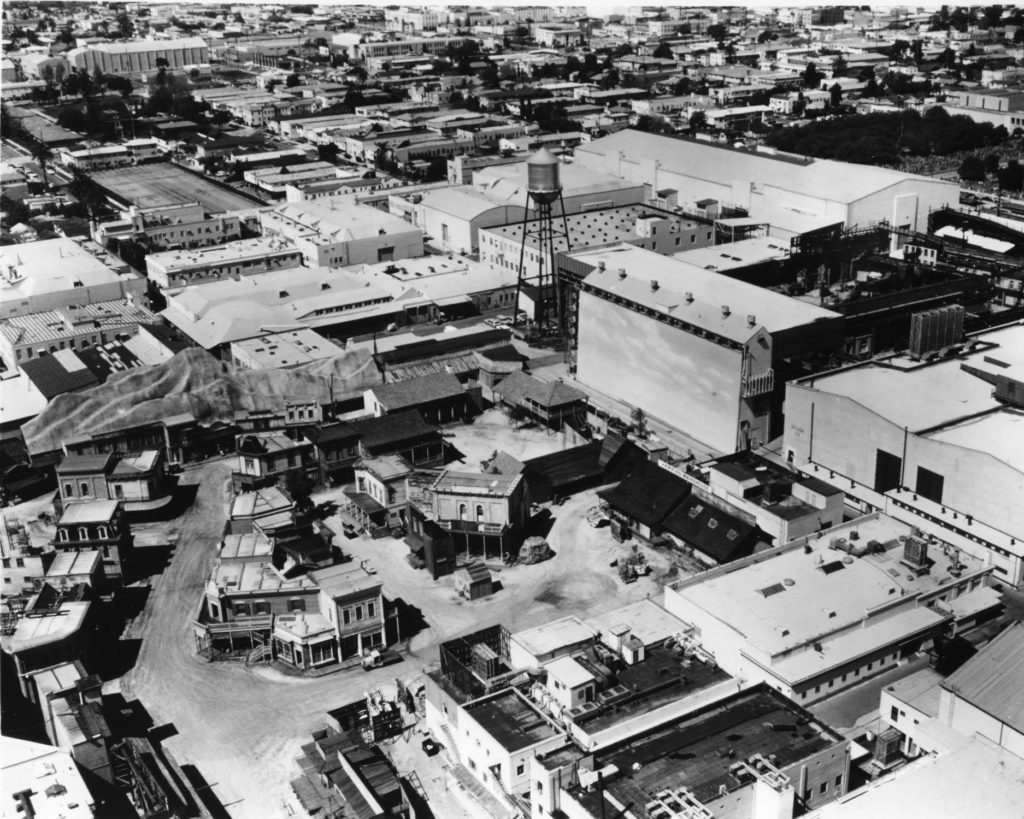
Paramount Mountain, Date Unknown 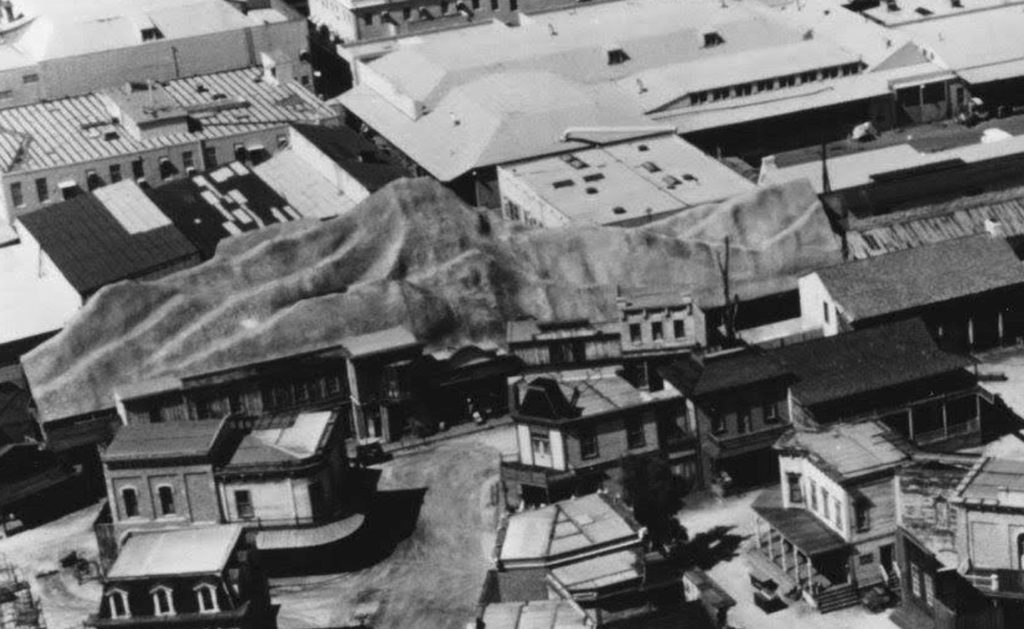
Paramount Mountain, Close-Up, Date Unknown -
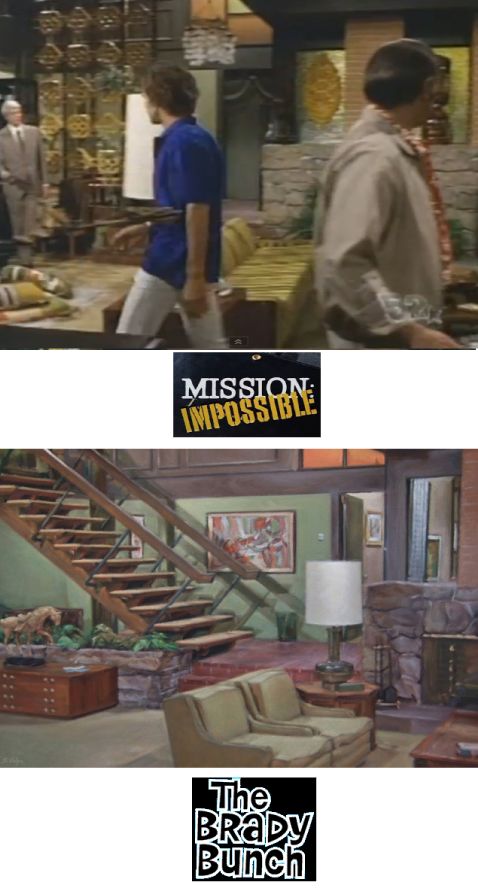
The Day Mission: Impossible Invaded The Brady Bunch House
One of the best things about fictional environments is that we can project our dreams on them. And kids of the 1970s universally projected dreams onto The Brady Bunch house.
We all wanted to live there. It was grander, fancier, and more modern than our own houses. Even that oh-so-fake backyard, with its Astroturfed lawn and false background blue sky, was very inviting in its sterility: it felt safe.
So, one of the worst things that can happen with a beloved fictional environment is when that fantasy is punctured. Maybe you visit the set and see it in all its blandness. Or you see production stills of the set–lit and empty. Or the rare photo of a studio guy pushing a broom across the set. The fantasy is dead.
Or–two dreams collide.
May I Borrow Your Set, Please?
When I first heard that the IMF (Impossible Missions Force) from the original Mission: Impossible TV show had invaded The Brady Bunch house, I thought it was a joke. I thought it had to be a stupid mash-up, where the IMF barges in with guns and– Cut to a shot of Cindy Brady holding a cap gun! Not so.
Both were filmed at Paramount Studios in the late 1960s and early 1970s, so sets would have been reused. Very Brady Blog shows us another Paramount set shared by the two shows.
In the MI episode “Double Dead,” aired on February 12, 1972, the IMF enter a house that every person of a certain age will immediately know. Directly below, actors Linda Day George and Paul Koslo, enter The Brady Bunch house. Readers will recognize the green divider, wide door, red tile floor, and rock wall. Even the Chinese cabinet to the right and the little bull sculpture on the divider are the same. Below that, we see Alice answering the door.
And moving along toward the familiar Brady Bunch staircase area, we see that the staircase itself has been removed. But we can still make out the colored glass window above the stairs and rock fireplace.
Here is a YouTube of that clip from MI:
